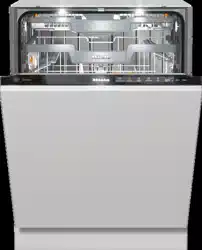Documents: Go to download!
User Manual
- User Manual - (English)
- Product Sheet - (English)
- Mounting plan - (English)
- Warranty conditions - (English)
- Guide to the appliance
- Loading the dishwasher
- Detergents
- Operation
- Program overview
- Cleaning and care
- Troubleshooting
Table of contents
Owner Manual Dishwashers
Guide to the appliance
Machine overview

- Top spray arm
- 3D MultiFlex Tray (depending on model)
- Upper basket (depending on model)
- Middle spray arm
- Aeration valve
- Bottom spray arm
- Filter combination
- Salt reservoir
- Data plate
- Rinse aid reservoir
- Detergent compartment
- AutoDos detergent outlet
- AutoDos (automatic dispensing)
Control panel

- In-operation indicator light
For indicating an ongoing wash program when the door is closed.  On/Off sensor button
On/Off sensor button
For turning the dishwasher on and off. Remote start sensor button
Remote start sensor button
For activating/deactivating the Remote start option.- Touch display
For further information, see “Display functions” under “Guide to the appliance”. - Back sensor button
For navigating back to the previous menu or deleting values which have been set previously. - Home sensor button
See other models: KM 3474 G 41GFE036USA 41HBE030USA 41KCE043USA SEB228
For returning to the Programs menu.
These operating instructions apply to several different dishwasher models of different heights.
The specific dishwasher models are referred to as follows: Standard = 31 11/16" (80.5 cm) high dishwashers (integrated) and 33 1/4" (84.5 cm) high dishwashers (freestanding) XXL = 33 1/4" (84.5 cm) high dishwashers (integrated).
Display functions
The display is used to select or set the following:
- the program
- The options
- the Timer
- the Settings
The display can show the following:
- the program name
- the program stage
- The estimated time left for the program to run
- Any relevant fault messages and information
To save energy, the dishwasher turns off after a few minutes if you do not press any sensor buttons during this time.
Touch the  sensor button to turn the dishwasher back on.
sensor button to turn the dishwasher back on.
The sensor button on the control field and in the display react to fingertip contact.
The touch display can be scratched by pointed or sharp objects, e.g., pens.
Only touch the display with your fingers.
Touch the required menu option to select it.
The currently selected setting is marked in orange and can be changed.
The OK sensor button in the display is used to confirm a message or setting and to move to another menu level.
To exit a sub-menu again, use the Back sensor button.
Touch the Home sensor button at any time to return to the Programs menu.
If you do not press any sensor buttons for several seconds, the display will revert to the previous menu. You will then have to enter your settings again.
Examples of how to operate the appliance
Main menu
Use the Back sensor button to switch from the Programs menu to the main menu.

In the main menu, you can choose the Programs menu to select programs as well as the Settings menu.
You can alter the dishwasher’s controls to suit changing requirements in the “Settings” menu (see “Settings”).
Option lists
You can scroll to the right or the left by swiping your finger across the display.

The orange scroll bar at the bottom of the display indicates that further options are available.
You can change the order of programs listed in the Programs menu by pressing and holding a program name and dragging it to the place you want.

After selecting a program, the Options menu is displayed. This is where you can select any options you want, activate the timer, and view the energy and water consumption with the  Estimate function.
Estimate function.
Numerical values
You can set numerical values in some menus.

You can set the numbers by touching the numerical keypad that you want to change.
You can then set the numbers using the  sensor buttons.
sensor buttons.
Use the OK sensor button to accept the set numerical value.
Keeping the relevant  or
or  sensor button pressed will increase or decrease the time automatically.
sensor button pressed will increase or decrease the time automatically.
Loading the dishwasher
General information
Remove coarse food residues from dishes.
There is no need to pre-rinse items under running water.
WARNING: Damage can be caused by ash, sand, wax, lubricating grease, or paint.
These substances will contaminate the dishwasher and can then no longer be removed.
Do not wash items soiled with these substances in the dishwasher.
Dishes can be loaded anywhere in the baskets, but the following notes should be observed:
- Do not place dishes and utensils inside other items where they will cover one another.
- Load the dishes so that water can access all surfaces. This ensures that they get properly cleaned.
- Make sure that all items are securely positioned.
- Hollow items such as cups, glasses, pans, etc., must be inverted in the baskets.
- Tall, narrow, hollow items such as champagne glasses should be placed in the center of the basket rather than in the corners. This ensures the hollow items are more easily accessed by the water jets.
- Concave items such as mugs or bowls should be placed at an angle so that the water can run off.
- The spray arms must not be blocked by items which are too tall or hang through the baskets. Test for free movement by manually rotating the spray arms.
- Make sure that small items cannot fall through the holders in the baskets.
Small items such as lids should therefore be placed in the 3D MultiFlex Tray or cutlery basket (depending on model).
Some foods such as carrots, tomatoes, or ketchup may contain natural dyes. These dyes can discolor plastic items in the dishwasher if large quantities of these foods are in contact with the dishes inside the machine. The stability of plastic items is not affected by this discoloration.
Washing silverware can also cause plastic items to discolor.
Wash items not suitable for dishwashers:
- Wooden cutlery and dishes or items with wooden parts. These may discolor and fade. The glue used in these items is not dishwasher-proof and wooden handles may come loose after being washed in a dishwasher.
- Craft items, antiques, valuable vases, and decorative glassware. Such items are not suitable for dishwashers.
- Plastic items that are not heat resistant. The high temperatures in the dishwasher may cause them to melt or lose shape.
- Copper, brass, tin and aluminum items. These may discolor or become dull.
- Colors painted over a glaze. These may fade after a number of washes.
- Delicate glassware and glassware containing lead crystal. Clouding may occur over time.
Silver
Silver that has been in contact with foods containing sulphur can discolor. These include egg yolk, onions, mayonnaise, mustard, fish, and marinades. Silverware previously cleaned with a silver polish may still be damp or spotted at the end of a program, where water has not run off smoothly.
Tip: Rub the silver dry with a cloth.
WARNING: Damage due to caustic alkaline detergents.
Aluminum parts (e.g., the grease filters of ventilation hoods) can be damaged by caustic alkaline detergents. In extreme cases, there is a risk of an explosive chemical reaction (such as an explosive oxyhydrogen gas reaction).
Aluminum components must not be cleaned in the dishwasher with caustic alkaline commercial or industrial detergents.
Tip: When purchasing new dishes and cutlery, make sure they are dishwasherproof if you want to wash them in the dishwasher.
Glass care
- Clouding may occur on glasses after frequent washing in the dishwasher. When washing delicate glassware in the dishwasher, ensure that only a special glass-care program with very low temperatures is selected (see “Program overview”). This will reduce the risk of clouding.
- Purchase glassware that is dishwasher-safe (e.g., Riedel glassware).
- Use detergents with glass protective additives.
Loading examples
Loading for 10 standard place settings with cutlery tray
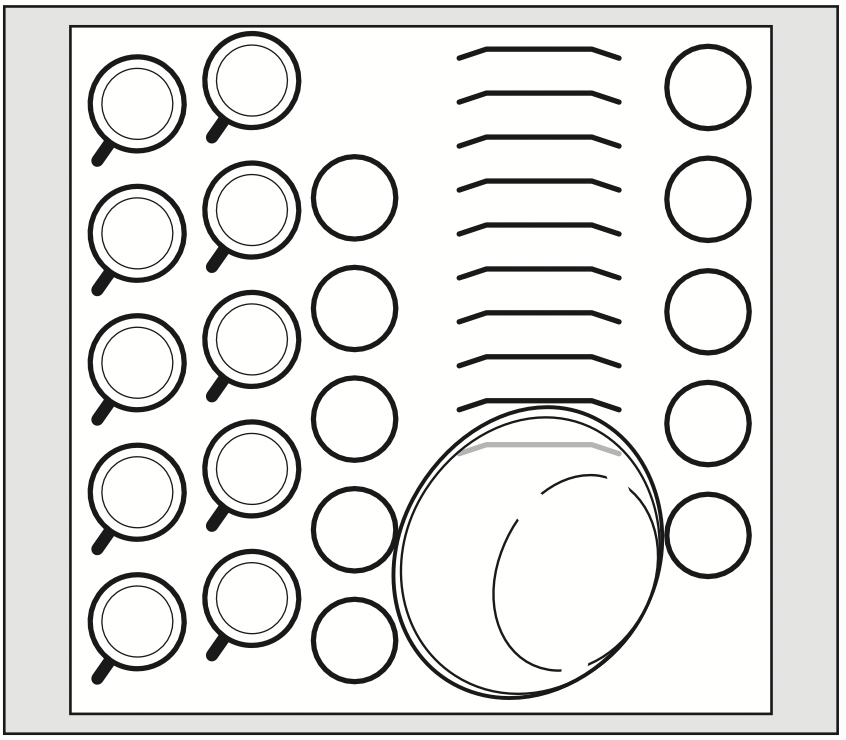
Upper basket
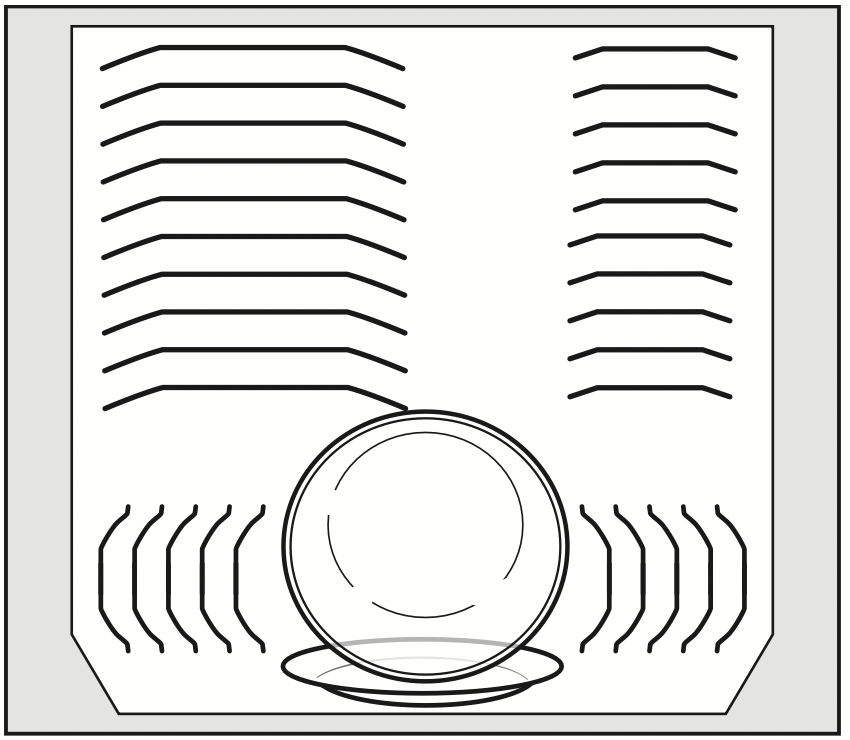
Lower basket
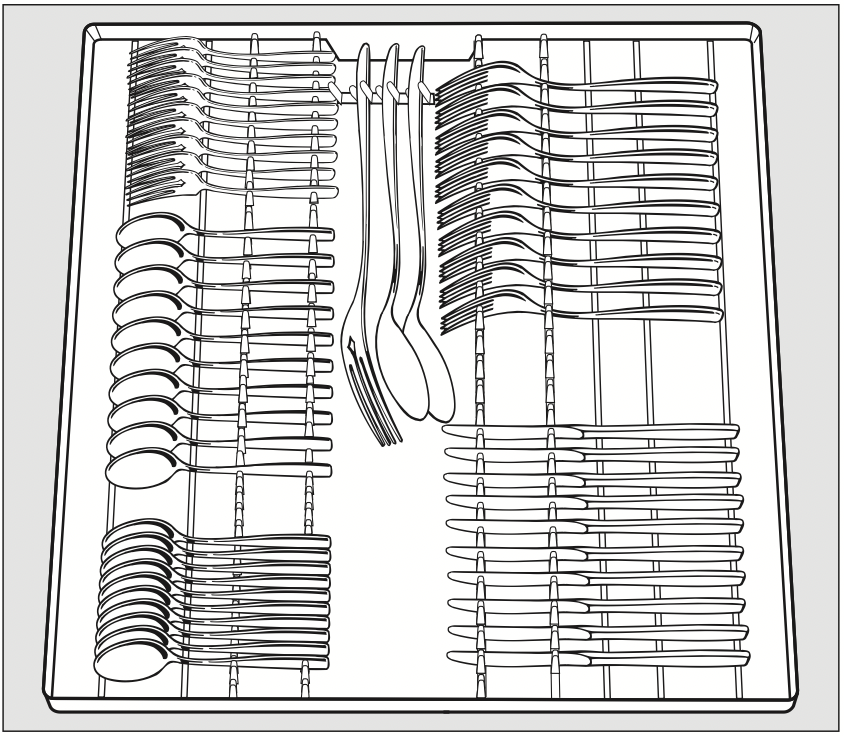
Cutlery tray
Loading for 16 standard place settings with cutlery tray
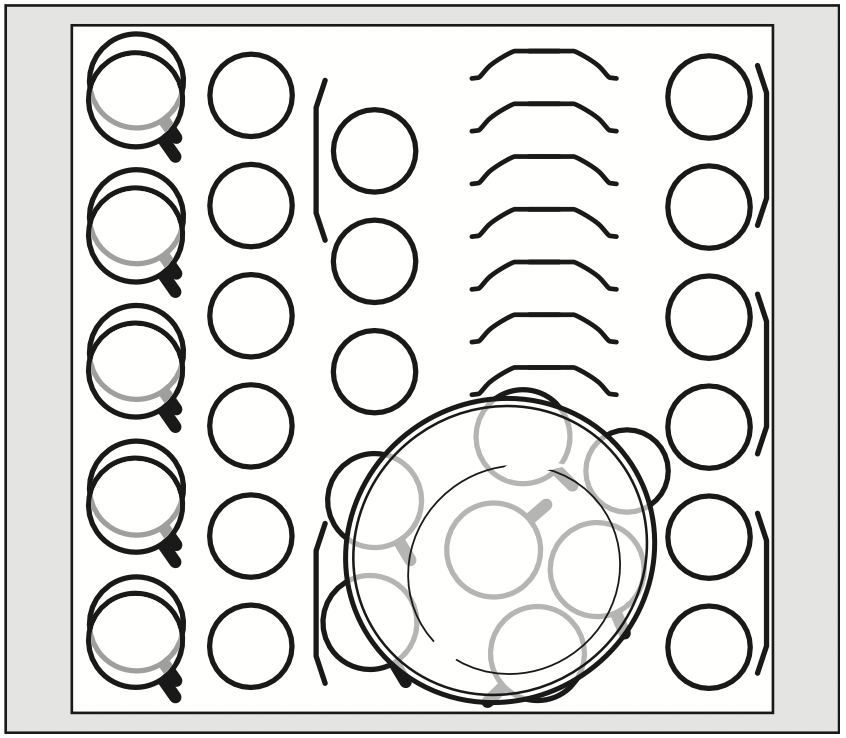
Upper basket
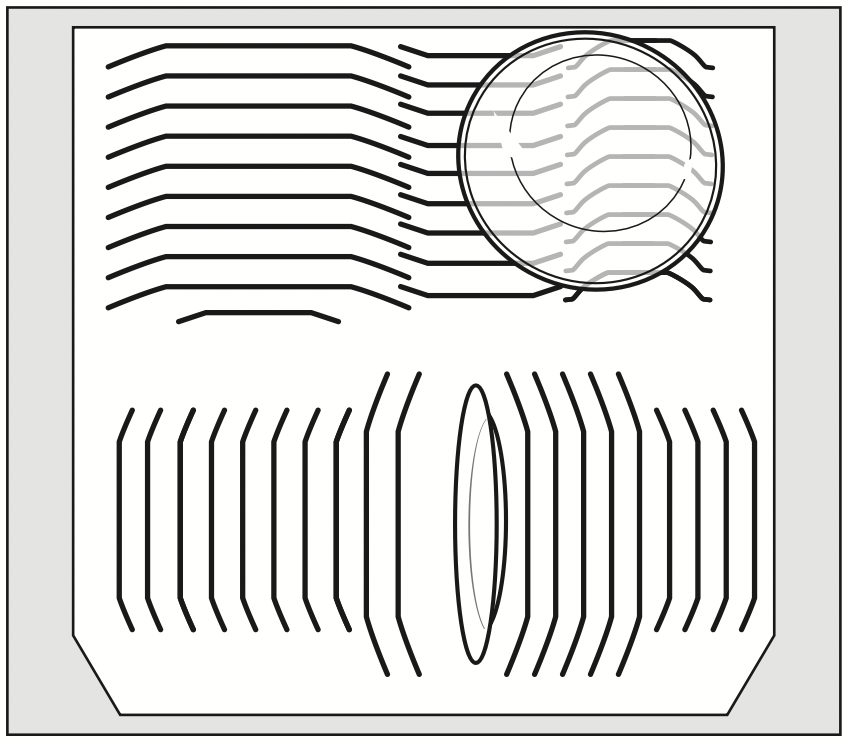
Lower basket
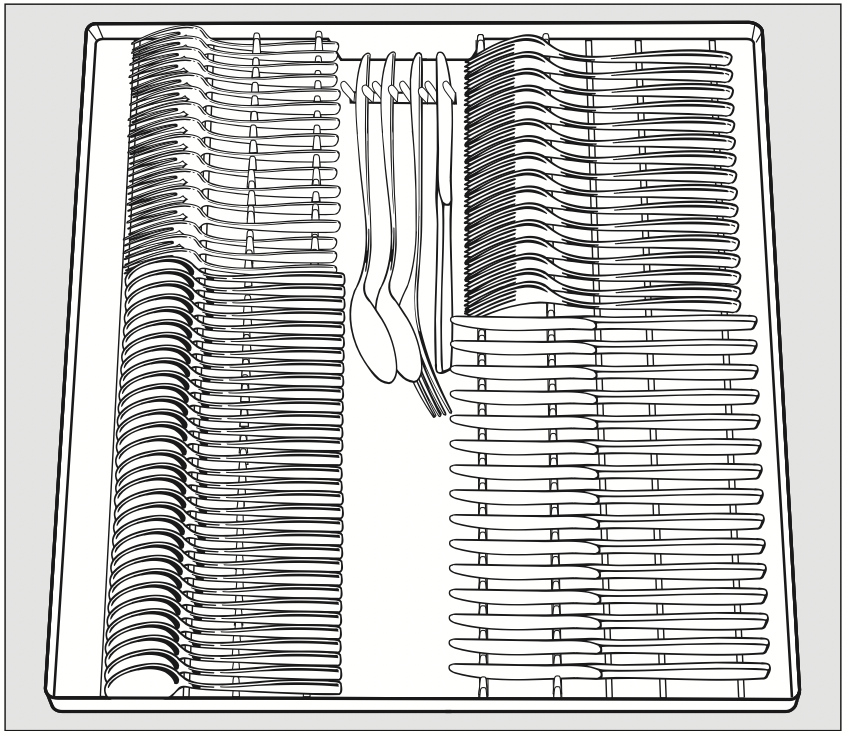
Cutlery tray
Upper basket
Loading the upper basket
WARNING - Risk of damage due to water leakage.
If you run the dishwasher without the upper basket, water can leak out of the dishwasher.
Only run the dishwasher with the upper basket in place (except during the Tall Items program, if available).
- Use the upper basket for small, lightweight, and delicate items such as cups, saucers, glasses, dessert bowls, etc.
Shallow pans or casserole dishes can also be placed in the upper basket. - Long items such as soup ladles and mixing spoons should be placed lying down across the front of the upper basket.
Loading the FlexCare cup rack
You can put cups, small bowls, and flat dishes on the FlexCare cup rack. Glasses can be arranged along the cup rack so they sit securely during the program.
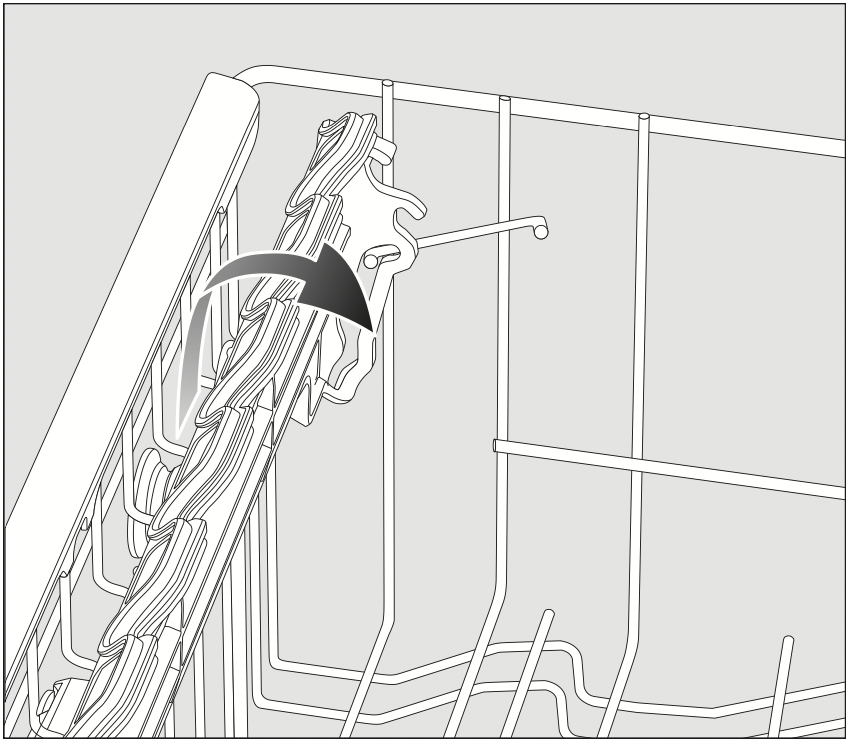
- Lower the cup rack to do so.
- Raise the cup rack upwards to make room for tall items.
Adjusting the FlexCare cup rack
You can set the height and depth of the cup rack at 2 different levels so that it can accommodate larger cups and so that taller items can be placed underneath it.
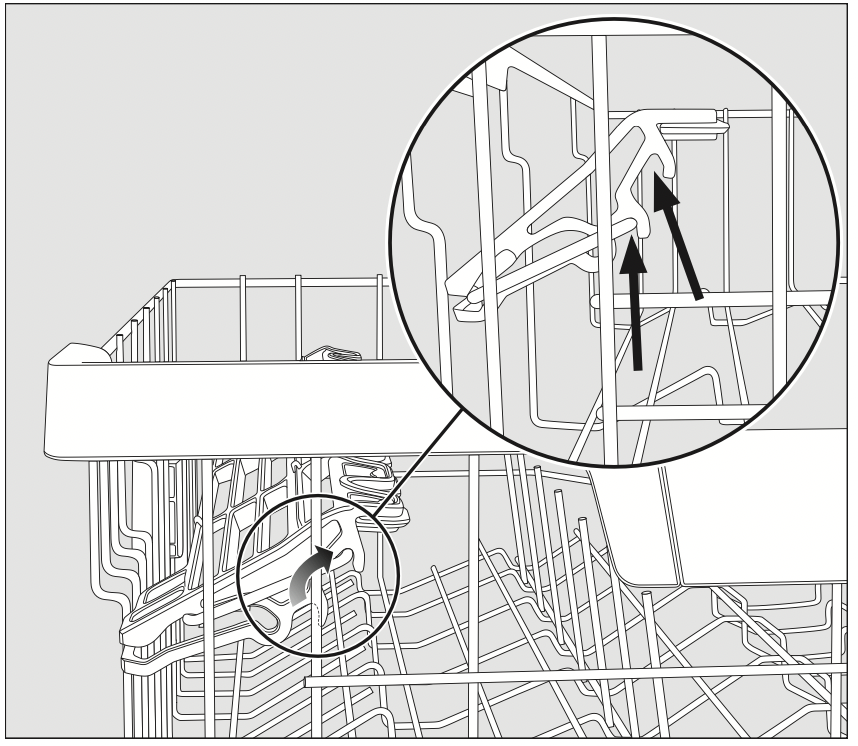
- Pull the cup rack upwards and click it into the desired position (see arrow).
Loading the silicone elements of the FlexCare cup rack
The silicone elements in the cup rack are specially designed to hold tall glasses with long stems securely.
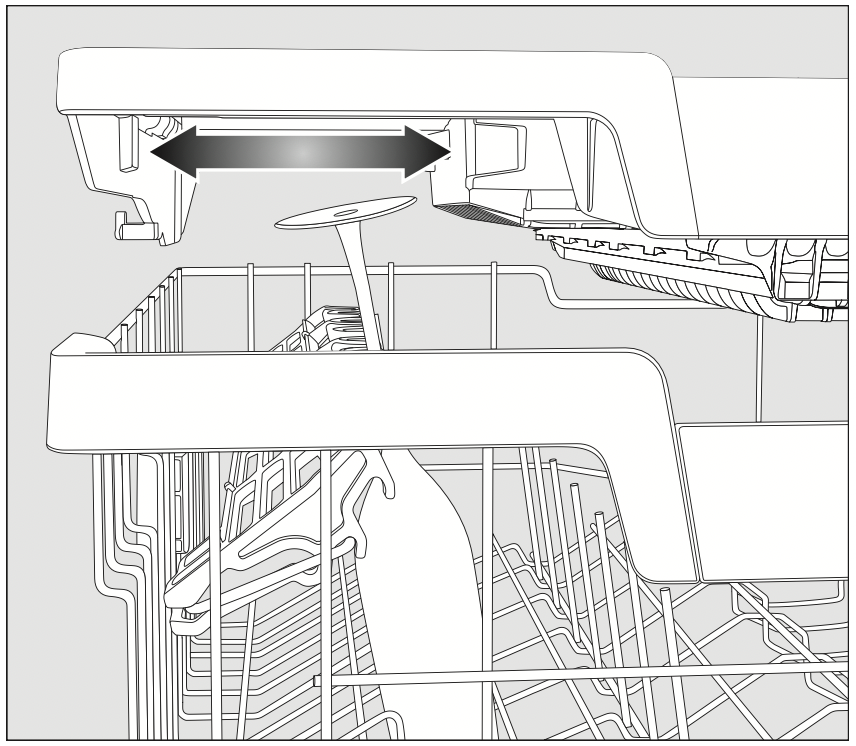
- Lower the cup rack and lean the glasses against the openings.
- If you wish you can adjust the left insert of the 3D MultiFlex Tray to make space for taller glasses (see “3D MultiFlex Tray” under “Cutlery”).
Lowering the spikes
On both right-hand rows of spikes, you can lower every other spike to make it easier to arrange larger dishes, like cereal bowls.
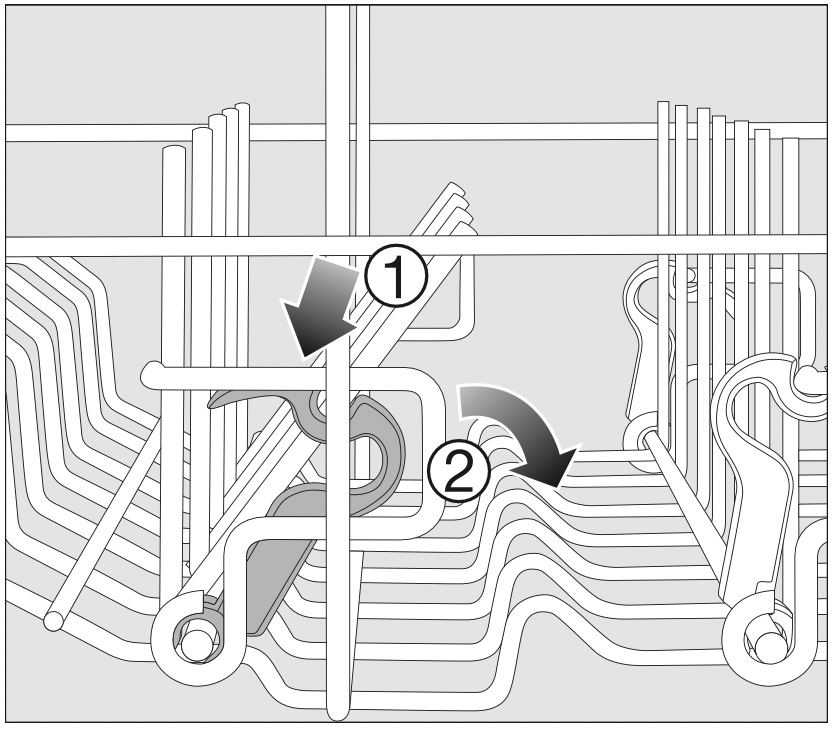
- Press the yellow lever downwards 1, and then lower the dark gray spikes 2.
- Place the bowls vertically in the row of spikes.
Adjusting the upper basket
In order to gain more space for taller items, the upper basket can be adjusted on 3 levels with 3/4" (2 cm) between each level.
The upper basket can also be set at an angle so that water can run off freely from recesses. Make sure, however, that the basket can slide smoothly in and out of the wash cabinet.
- Pull out the upper basket.
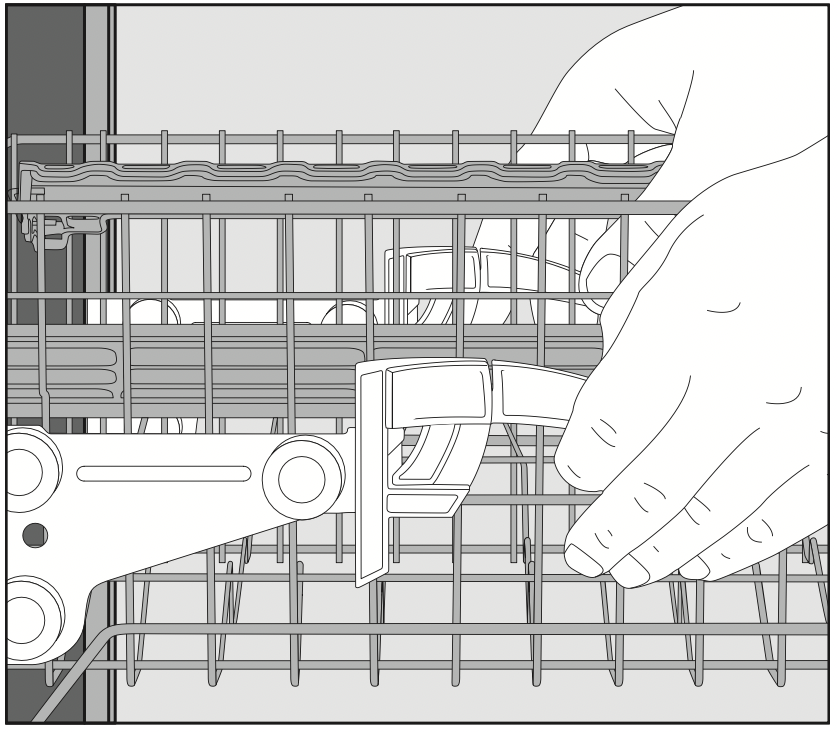
To raise the upper basket:
- Lift the basket until it clicks into place.
To lower the upper basket:
- Pull upwards on the levers at either side of the upper basket.
- Adjust the basket to the desired height and then push the levers securely back down into position.
When adjusting the upper basket, make sure it does not block the middle spray arm.
Lower basket
Loading the lower basket
- Place larger and heavier items such as plates, serving platters, saucepans, bowls, etc., in the lower basket.
Glasses, cups, and small plates and saucers can also be placed in the lower basket.
Loading the MultiComfort area
The rear section of the lower basket is used for washing cups, glasses, plates, and pots.
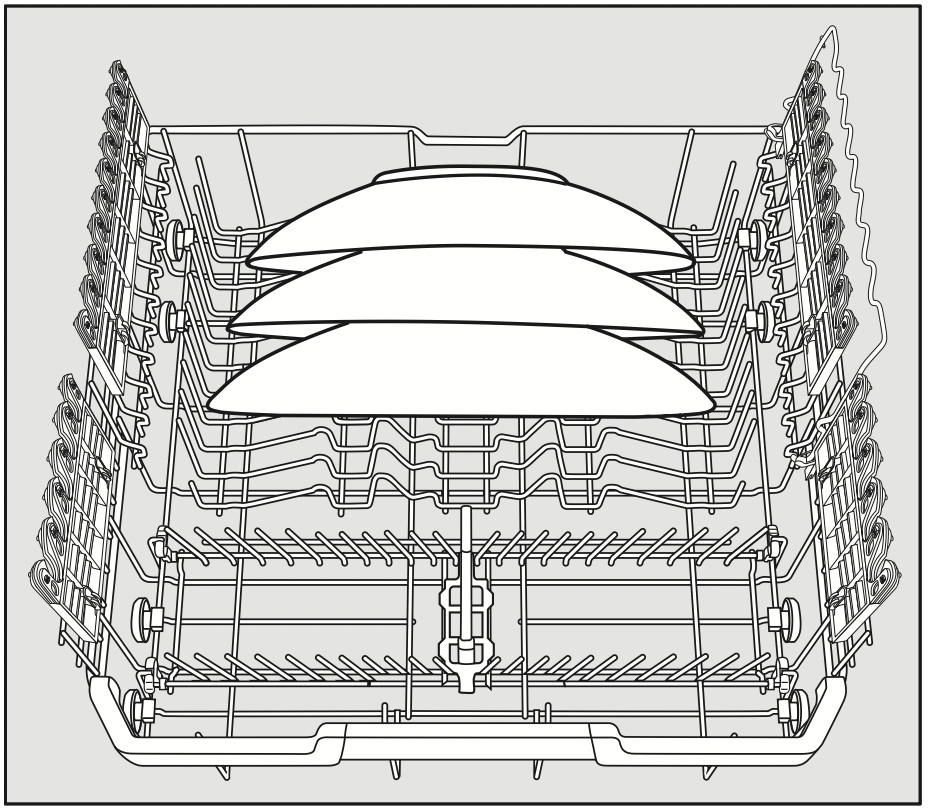
- Place very large plates in the center of the lower basket.
Tip: When tilted, plates up to 13 3/4" (35 cm) in diameter can be accommodated.
Lowering the spikes
The rows of spikes at the front are used for loading plates, soup bowls, platters, dessert bowls, and saucers.
The spikes can be lowered to make more room for large items, e.g., pots, pans, and dishes.

- Press the yellow lever downward 1, and then lower the spikes 2.
Loading the FlexCare glass holder with MultiClips
The silicone elements in the glass holder provide a stable and secure hold for delicate stemware.
- Stemware such as wine glasses, champagne flutes, and beer glasses can be leaned against the glass holder or suspended from it.
- The glass holder can be raised to make more room for tall items.
You can set the glass holder at 2 different heights.

- Slide the glass holder to the desired height until the catches click into place at the top or the bottom.
The MultiClips enable you to fasten wash light items such as those made from plastic onto the glass holder.

- Fold up the MultiClips.
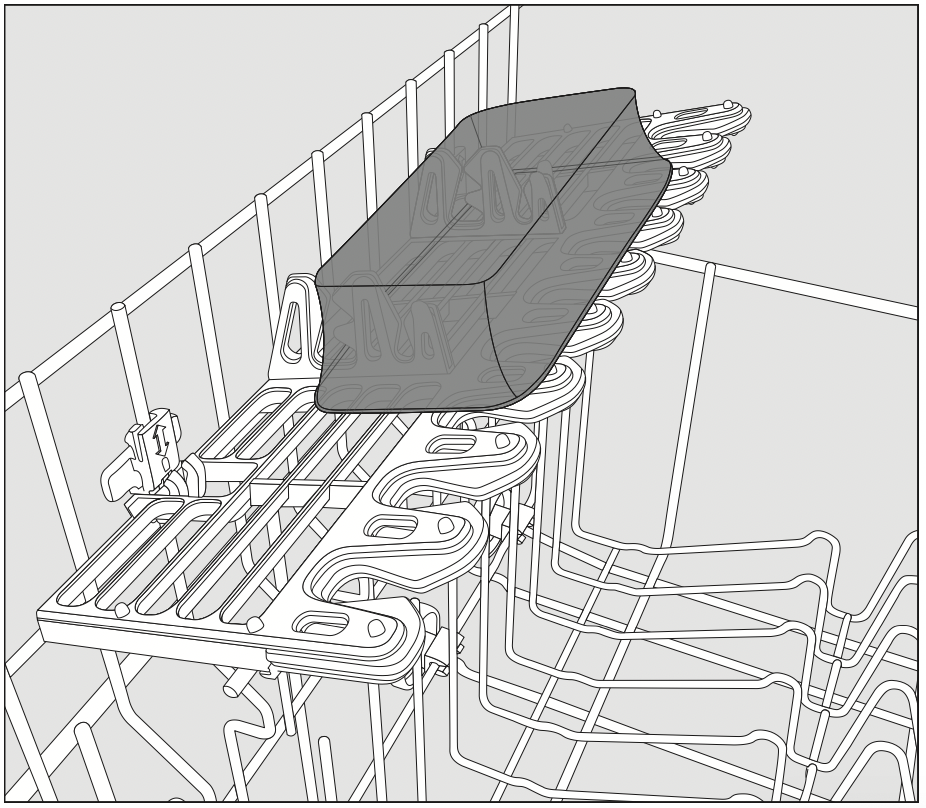
- Secure light items to the MultiClips.
Loading the glassware rail
This rail is designed to hold tall glasses and glasses with stems securely.

- Lower the rail and lean tall glasses against it.
Lowering the bottle holder
The bottle holder can be used to keep narrow items such as milk and baby bottles secure during a program.
- Raise the bottle holder upwards and push it down until it clicks into place.

- If the bottle holder is not needed, lift it up using the yellow lever 1 and fold it to the side 2.
Filters
You can also wash Miele VentilationHood Filters.
Select the Filters program for optimum dishwashing results.
WARNING: Damage caused by protruding parts.
Protruding parts can damage the dishwasher.
Load the filters in such a way that no corners protrude over the side of the basket.
WARNING: Damage caused by wash items with sharp edges.
Heavy and sharp wash items can damage the coating of the basket struts.
Load the filters carefully.
WARNING: Risk of scalding due to hot water.
At the end of the program, the filters may still contain hot water.
Be careful when unloading the filters.
Loading the filters
You can wash 2 ventilation hood filters in the upper basket and 2 filters in the lower basket at once.
- If you only want to wash 2 filters, put them in the upper basket.
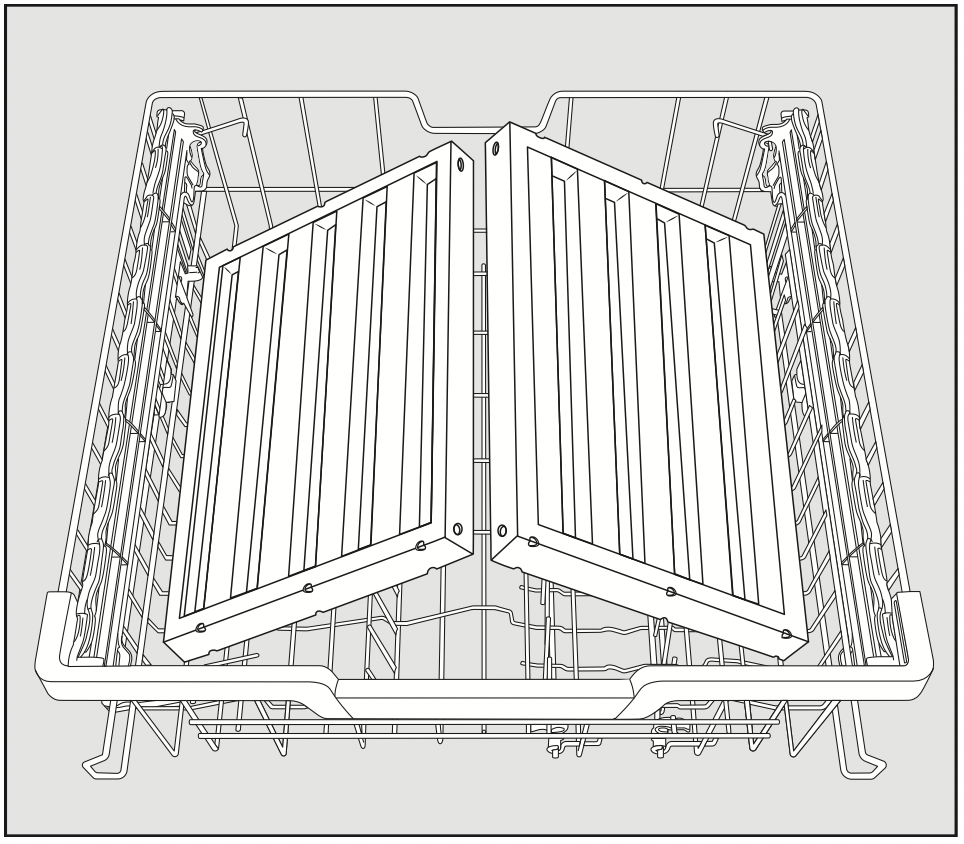
- Set the upper basket into the top or middle position if you load filters in the lower basket.
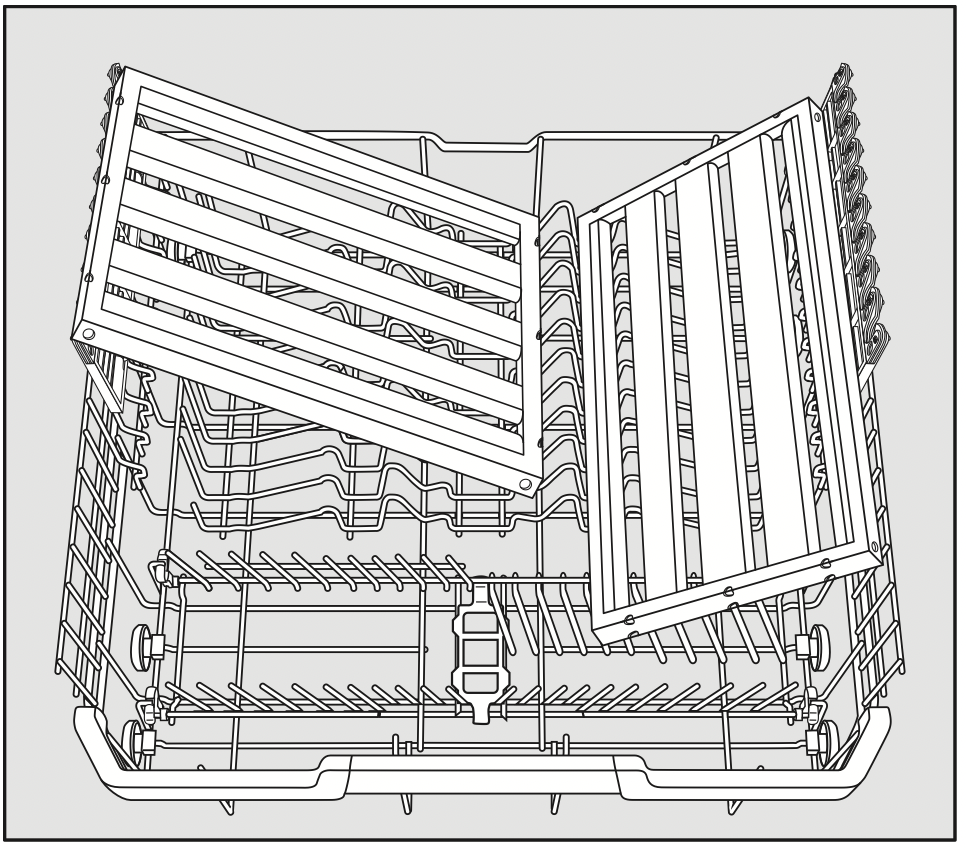
Cutlery tray
- Load the cutlery into the 3D MultiFlex Tray.
Loading the 3D MultiFlex Tray
To make unloading easier, utensils should be grouped in zones, one for knives, one for forks, one for spoons, etc.
Spoon heads should be placed in contact with at least one of the serrated retainers on the base of the cutlery tray to ensure that water runs off them freely.
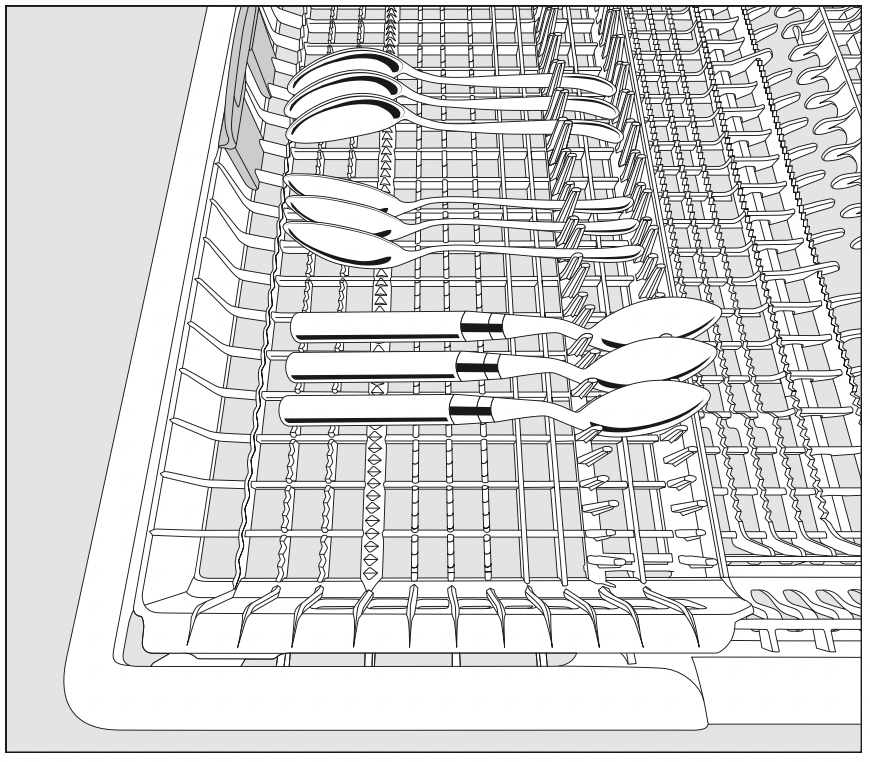
- If spoon handles do not fit between the holders, then lay them the other way round.
You can push the left insert to the middle in order to accommodate tall items and long stemmed glasses in the upper basket (see “Loading the silicone elements of the FlexCare cup rack” under “Upper basket”).
You can put large and long utensils in the recessed center part of the tray.
Arrange tall items (such as cake platters) so that they do not block the upper spray arm.
You can adjust the height of the righthand insert to create more space in the right-hand part of the tray for larger utensil items or smaller dishes.
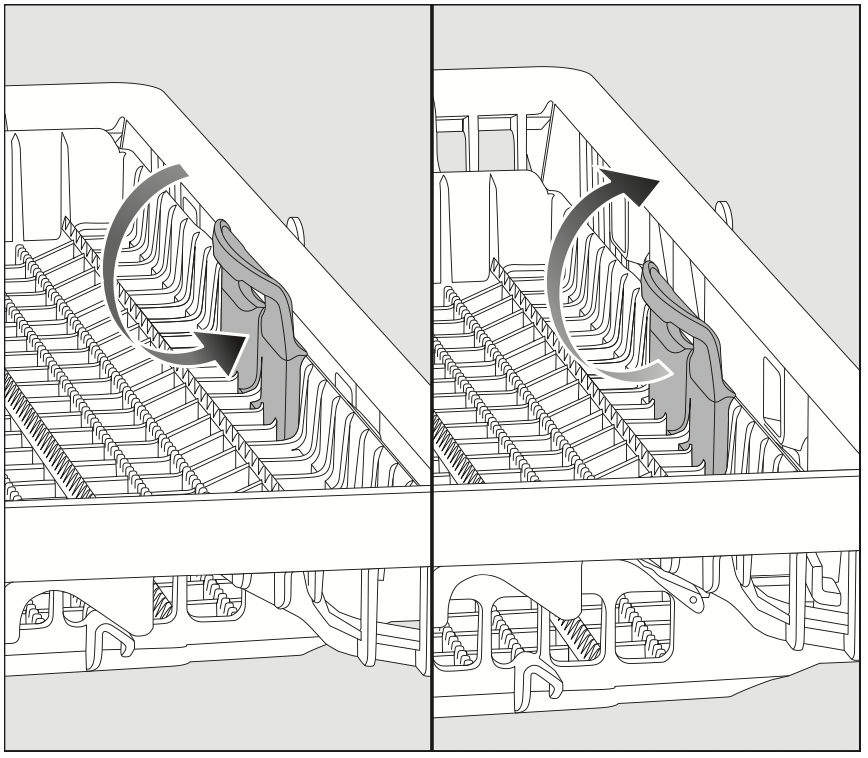
-
Pull the insert inward by the yellow handle and click it into place in one of the two positions.
Detergents
Active ingredients
WARNING: Damage caused by using unsuitable detergents.
Detergents that are not suitable for domestic dishwashers can cause damage to the dishwasher or to the wash items.
Only use detergents formulated for domestic dishwashers.
Modern detergents contain various active ingredients, the most important of which are:
- Water softening complexing agents to prevent calcification.
- Alkalis to aid removal of dried-on soiling.
- Enzymes to break down starch and loosen protein.
- Oxygen-based bleaching agents to remove colored stains (e.g., tea, coffee, tomato sauce).
Most dishwasher detergents are mildly alkaline and contain enzymes and oxygen-based bleaching agents.
There are different types of detergent:
- Powder and liquid gel detergents.
These detergents allow you to adjust the amount dispensed according to the amount of wash items and the level of soiling. - Tab detergents. These are suitable for most levels of soiling.
As well as the usual detergents, combination products are also available. These contain rinse aid and water softener (reactivation salt).
Only use these combination detergents for the water hardness levels recommended by the manufacturer on the packaging.
The cleaning and drying performance of these combination detergents can vary greatly.
For optimum cleaning and drying results, use dishwasher detergent and add salt and rinse aid separately.
WARNING - Risk of chemical burns from detergent.
- Dishwasher detergents can cause burning on the skin and in the eyes, nose, mouth, and throat.
- Avoid contact with detergents.
- Do not inhale or ingest powder detergents. Do not swallow dishwasher detergents. Seek medical attention immediately if detergent has been swallowed or inhaled.
- Keep children away from detergents. Detergent residues could still be present in the machine. Keep children away from the dishwasher when the door is open. Do not fill the detergent dispenser until just before starting the program and activate the door safety lock (depending on model).
Detergent dispensing
There are 2 ways of dispensing the detergent.
During automatic dispensing, the AutoDos function will automatically dispense the required amount of detergent for each program sequence once a PowerDisk has been inserted (see “Automatic dispensing/AutoDos” under “Detergent”).
If you do not wish to use AutoDos, you can manually dispense the detergent into the detergent compartment. This means you will have to fill the required amount of detergent into the detergent compartment before each program (see “Manual detergent dispensing” under “Detergent”).
Automatic dispensing/AutoDos
Before you can use AutoDos, you must insert a PowerDisk containing powder detergent into the PowerDisk compartment.
One PowerDisk contains enough detergent for approx. 20 rinse cycles, depending on the chosen program.
PowerDisks are available to order directly from Miele’s online store, Miele Customer Service, or from your Miele dealer.
WARNING - Risk of chemical burns from residual detergent.
Detergents have a caustic effect. This can cause health problems and damage to surfaces. If the AutoDos is used incorrectly or leaks, residual detergent may drip onto the floor area in front of the dishwasher.
Always remove residual detergent from in front of the dishwasher immediately.
Activating AutoDos
- Turn the dishwasher on using the
 sensor button.
sensor button. - Before you first use AutoDos, remove the transport lock from the PowerDisk compartment and dispose of it appropriately.
- Insert a PowerDisk (see “Inserting a PowerDisk” under “Automatic dispensing/AutoDos”).
The AutoDos function will be activated automatically.
This setting applies to all programs and you can change it in a program's Options menu.
If no program is started for 48 hours, the PowerDisk will automatically be rotated so that the detergent does not clump together. If this happens, the message Powder refresh in progress will be shown in the display when the dishwasher is turned on. No detergent will be dispensed.
Inserting a PowerDisk
Turn on the dishwasher before you replace the PowerDisk so that the dishwasher recognizes it.
When the message PowerDisk almost empty appears, the reservoir contains sufficient detergent for 2–3 programs only.
Only replace the PowerDisk when the message PowerDisk empty. Deactivate AutoDos with OK. appears.
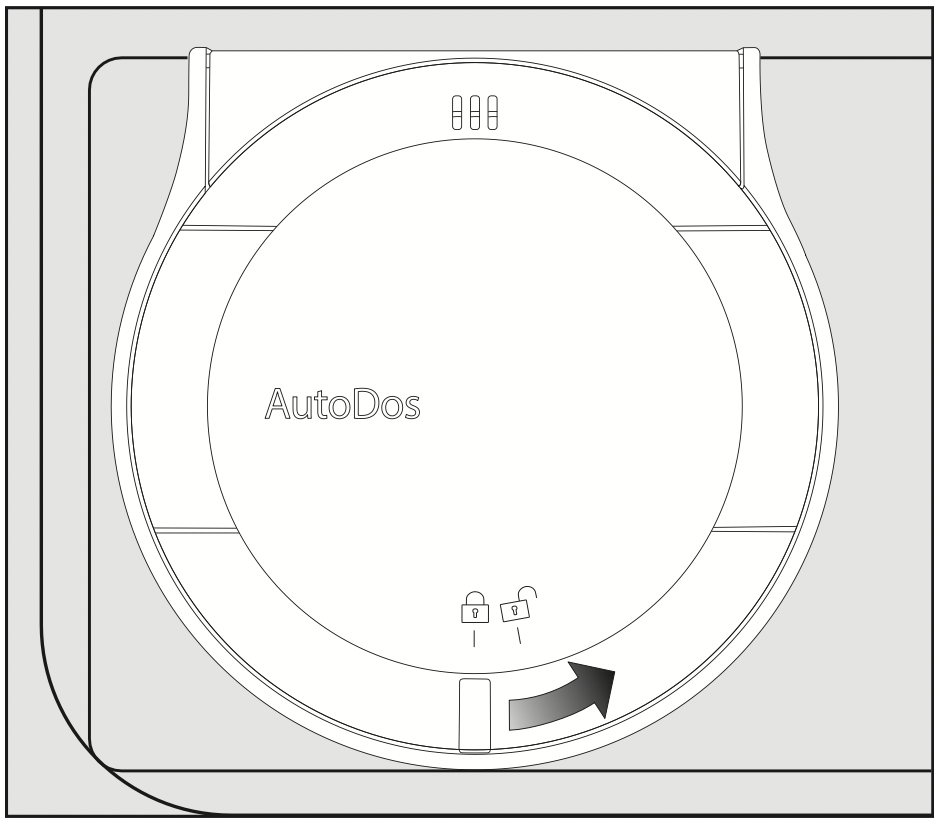
- Turn the AutoDos lid to
 and open it.
and open it.
The message AutoDos lid open will appear on the display.
- Remove the empty PowerDisk.
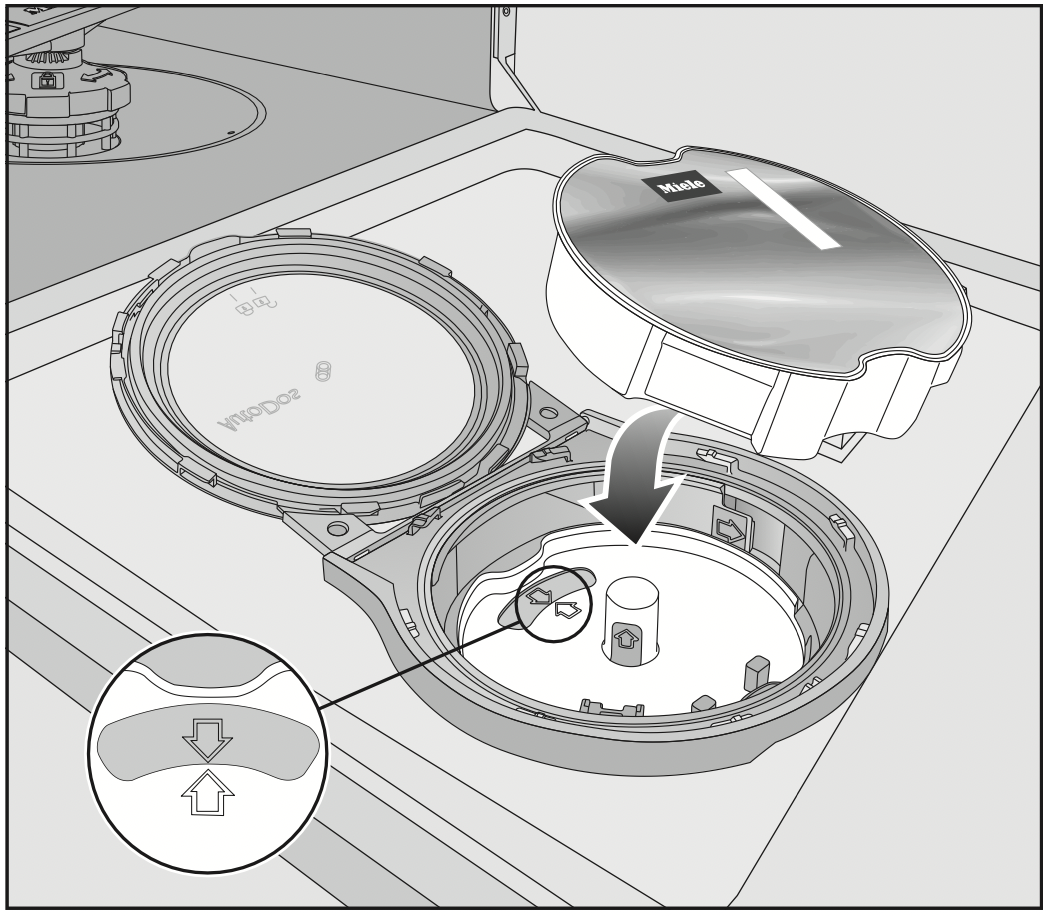
- If the arrows in the PowerDisk holder and in the viewing window are not pointing toward each other, remove the PowerDisk holder (see “Cleaning the AutoDos” under “Cleaning and care”).
- Put the holder back into place so that the arrows point toward each other and the holder lies flat.
When doing this, only touch the PowerDisk holder by the yellow tab in the middle. Do not touch the side tab. - Insert the new PowerDisk and press it evenly downward until it sits flush.
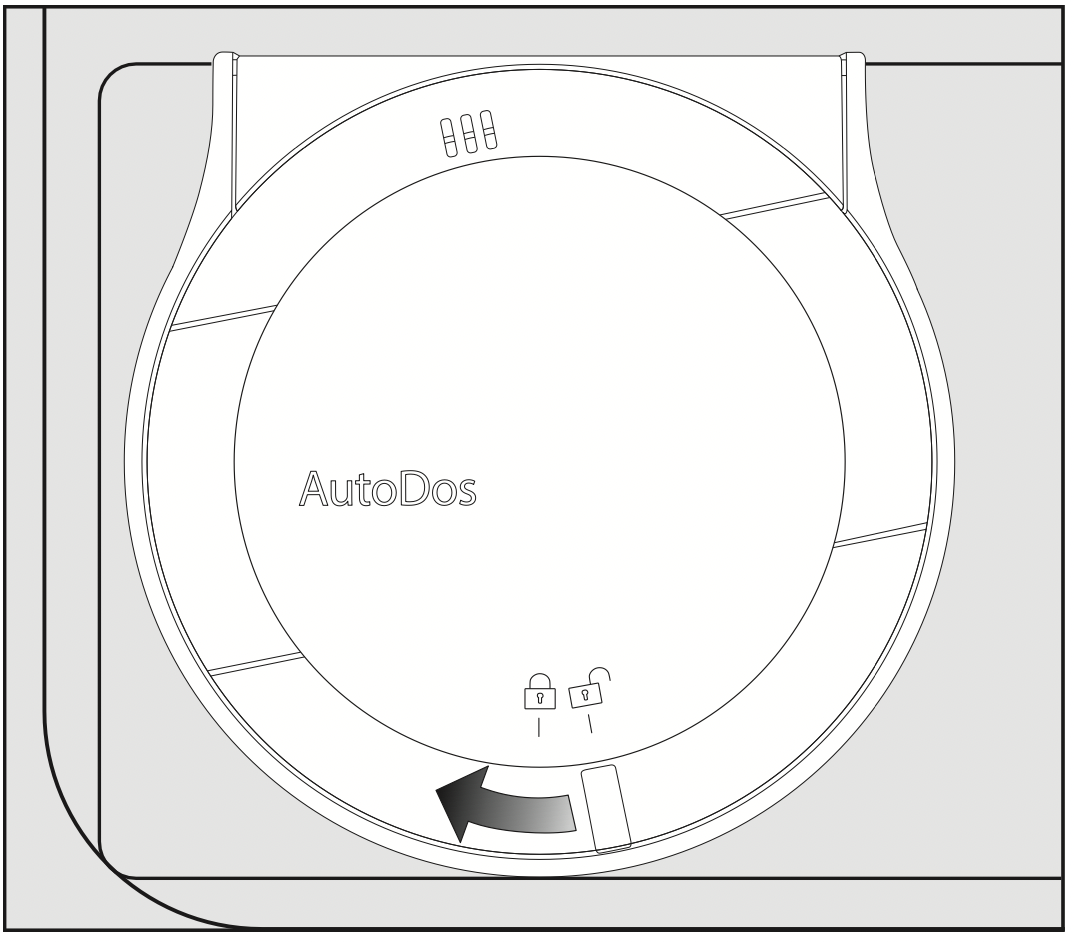
- Close the AutoDos lid and turn it until the lid handle is directly below the
 symbol.
symbol.
If the PowerDisk is not in the correct starting position, it will be rotated automatically and the AutoDos function will be activated.
Wait until this procedure ends before you start a program.
The AutoDos lid must be closed to prevent damage to the AutoDos. Always close the AutoDos lid before you close the dishwasher door. Otherwise, the AutoDos may become damaged.
Programs cannot start when the AutoDos lid is open.
The detergent powder must be dry so that it does not clump together. Do not fill the AutoDos with any type of fluid.
In order to ensure that the AutoDos works at its best, check it each time you replace the PowerDisk and clean it if needed (see “Cleaning the AutoDos” under “Cleaning and care”).
Manual detergent dispensing
Detergent must be manually dispensed if you have deactivated AutoDos in a program's Options menu.
Detergent dispensing
The detergent compartment holds a maximum of 3 1/2" tablespoons..
There are marks in the detergent compartment to aid with dispensing: 1 1/4, 2 tablespoons (20, 30 ml). When the door is opened to a horizontal position, they show the approximate fill level in ml and the maximum fill height.
- Follow the detergent dosage recommended by the manufacturer on the packaging.
- Unless directed otherwise, use one detergent tab or add 1 1/4 to 2 tablespoons (20 to 30 ml) of detergent to the detergent compartment, depending on the level of soiling of the dishware.
If you use less than the recommended amount of detergent, the dishware may not get properly clean.
Some tabs may not dissolve completely when the program QuickIntenseWash is used.
Adding detergent
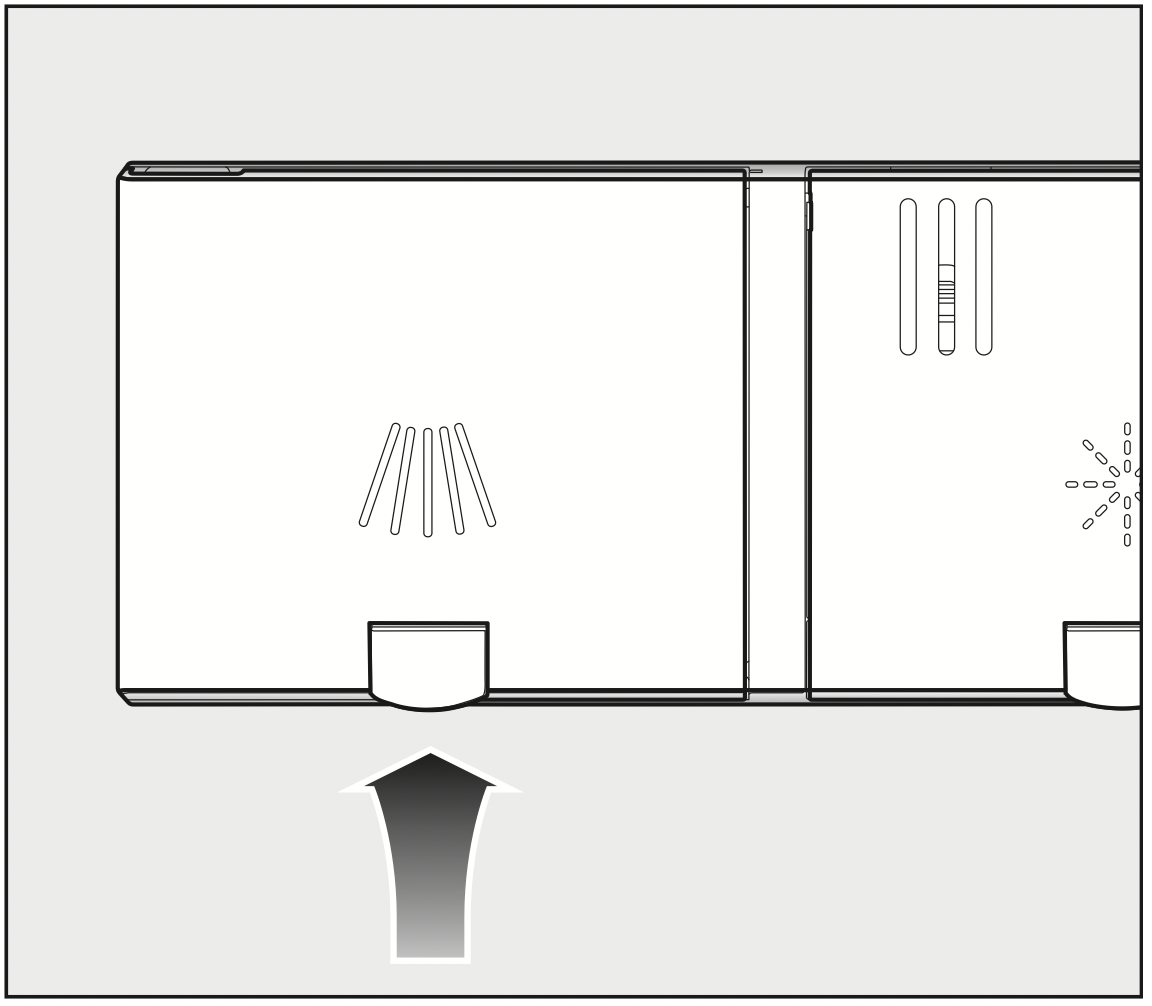
- Press the yellow button
 on the lid of the detergent compartment.
on the lid of the detergent compartment.
The lid will spring open.
The lid will also open at the end of a program.

- Add the detergent to the detergent compartment.
- Push the lid shut until you hear it click into place.
The detergent must not cause the detergent-compartment lid to get stuck. This can prevent the lid from opening during the program.
Do not overfill the detergent compartment.
- If you wish, deactivate automatic dispensing/AutoDos.
- Ensure that the detergent packaging is properly closed after use. This prevents the detergent from getting damp and clumping together.

- You can also apply a small amount of detergent to the inner panel of the door in programs that have a prewash stage (see “Program overview”).
Operation
Turning on the dishwasher
- Turn on the water supply if it is turned off.
- Open the door.
- Make sure the spray arms can rotate freely.
- Tap the
 sensor button.
sensor button.
If the dishwasher has been turned off for longer than 1 minute, you will need to hold the sensor button for a bit longer (wipe protection).
sensor button for a bit longer (wipe protection).
The Programs menu will appear in the display.
Selecting a program
Choose your program according to the type of load and the degree of soiling.
The different programs and their uses are described under Program overview.
- Select the program you want in the display.
The display will change to the Options menu.
You can now select the options (see “Options”).
To select a different program, touch the Back sensor button to return to the Programs menu.
If you want to control the dishwasher remotely using the Miele@mobile app, you will first need to activate the Remote start option (see “Activate Remote start” under “Options”).
- Close the door within 4 seconds.
Display of program duration
The estimated duration of the selected program appears on the display before the program begins. If the door is opened during the program, the time left until the end of the program is displayed.
The displayed duration may vary for the same program. It is influenced by, for example, the temperature of the incoming water, the reactivation cycle of the water softener, the detergent type, the amount of dishware, and how soiled it is.
When a program is selected for the first time, the display will show the average program duration for a cold water connection.
The program durations shown under “Program overview” refer to standard test loads and temperatures.
Each time a program is run, the control module calculates the program duration required depending on the temperature of the water taken into the dishwasher and the amount of dishes.
Starting a program
- Start the program by closing the door within 4 seconds of the last press of a button.
If necessary, confirm the previously displayed message with OK.
The in-operation indicator light comes on to show that a program has been started.
If you do not close the door within 4 seconds, the message Press “OK”
to continue will appear in the display.
The program cannot be started until you confirm the message by pressing the OK button and close the door within 4 seconds.
If you open the door, the message Dishware can be added may be displayed.
As long as this message is showing, dishware can be added without compromising wash results.
WARNING - Risk of scalding due to hot water.
During operation, water in the dishwasher may be very hot.
During operation, only open the door with extreme caution.
End of program
At the end of a program, the in-operation indicator light will be flashing slowly with the door shut. The audible signal may also be sounding.
The in-operation indicator light will go out 10 minutes after the end of the program if the door is closed.
The program has ended when the display shows the message  Finished.
Finished.
In some programs, if the AutoOpen function is activated, the door will automatically open slightly (see “AutoOpen” under “Settings”). This improves the drying process.
The drying fan may continue to run for a few minutes at the end of the program.
WARNING - Risk of damage due to steam.
Steam from the dishwasher could damage the edges of delicate countertops when you open the door at the end of the program if the blower is no longer running.
If you have deactivated the automatic door-opening function (see “AutoOpen” under “Settings”), but would still like to open the door at the end of the program, then make sure that you open the door fully.
Energy management
To save energy, the dishwasher will turn off automatically 10 minutes after the last time a sensor button is pressed or after the end of a program.
You can turn the dishwasher back on again with the  sensor button.
sensor button.
If the dishwasher has been turned off for longer than 1 minute, you will need to hold the  sensor button for a bit longer (wipe protection).
sensor button for a bit longer (wipe protection).
The dishwasher will not turn itself off while a program is running or if there is a fault.
Turning off the dishwasher
- Open the door.
- The dishwasher can be turned off at any time using the
 sensor button.
sensor button. - Confirm the query Turn appliance off? with Yes.
Turning the dishwasher off during a program stops the program.
You can also do this to stop an ongoing timer.
WARNING - Risk of damage from leaking water.
Leaking water can cause damage.
If the dishwasher is not going to be used for a longer period of time, e.g., during vacations, the water supply should be turned off.
Unloading the dishwasher
Dishes tend to break and chip more easily when they are hot. Allow the dishes to cool until they are comfortable enough to handle before unloading them.
The dishes will cool much faster if you open the door when the program has ended.
- First unload the lower basket, then the upper basket, and finally the 3D MultiFlex Tray (if present).
This will prevent water drops from the upper basket and 3D MultiFlex Tray from falling onto the dishes in the lower basket.
Interrupting a program
A program will be interrupted as soon as the door is opened.
After 4 seconds, the message Press “OK” to continue will appear on the display.
- Confirm with OK and close the door within 4 seconds.
The program will continue from the point at which it was interrupted.
WARNING - Risk of scalding due to hot water.
During operation, water in the dishwasher may be very hot.
During operation, only open the door with extreme caution.
Canceling or changing a program
If a program is canceled, important program stages may be missed.
A program should only be canceled in the first few minutes.
If a program has already started and you wish to cancel it, proceed as follows:
- Open the door.
- Touch the Back sensor button.
- Confirm the query with Yes.
The program is canceled.
If you would like to select another program:
- Touch the Back sensor button.
The display will change back to the Programs menu.
- If you have dispensed detergent manually, check whether the detergent compartment is still closed.
If the lid is already open, fill it with detergent again and close the lid. - Select the program you want, and then start it by shutting the door within 4 seconds.
The in-operation indicator light comes on to show that a program has been started.
 Timer
Timer
The timer  gives you several options for starting a program at a later time. The start or finish time of a program can be delayed. You can also use the EcoStart or SmartStart functions to benefit from cheaper energy rates at night.
gives you several options for starting a program at a later time. The start or finish time of a program can be delayed. You can also use the EcoStart or SmartStart functions to benefit from cheaper energy rates at night.
During manual detergent dispensing, the detergent will clump together if the detergent compartment is not dry, and this may mean it is not fully rinsed out.
When using the timer function, make sure that the detergent compartment is dry before adding detergent. Wipe dry with a cloth first, if necessary. Do not use any liquid detergents. These can leak out.
WARNING - Danger to health due to detergent.
To prevent children coming into contact with dishwasher detergent:
Do not fill the detergent dispenser until just before starting the program, i.e., before you activate the timer.
Activating the timer
- Open the door.
- Turn the dishwasher on using the
 sensor button.
sensor button. - Select the desired program.
- Touch the
 Timer sensor button.
Timer sensor button.
The  Timer sensor button lights up.
Timer sensor button lights up.
You can choose between the Start at,
Finish at, or EcoStart functions, or SmartStart if applicable.
- Select the function you want.
The last time set for the timer will be displayed and the hour number block will be highlighted.
- Select the time you want for the timer using the
 sensor buttons and confirm with OK.
sensor buttons and confirm with OK.
If, while you are setting the time, you do not apply any settings for several seconds, the display will revert to the previous menu. You will then have to enter your settings again.
After you have activated the timer, all the displays will turn off after a few minutes to save energy.
Setting “Start at”
With the Start at function, you set the exact time at which you want the program to start.
- Set the hours with the
 sensor buttons.
sensor buttons. - Touch the minute number block.
- Use the
 sensor buttons to enter the minutes and confirm your entry with OK.
sensor buttons to enter the minutes and confirm your entry with OK.
The saved start time for the selected program will appear in the display for several minutes.
- Close the door.
When the set time is reached, the program selected will begin automatically.
Setting “Finish at”
Use the Finish at function to set the latest time by which the program selected has to be finished.
- Set the hours with the
 sensor buttons.
sensor buttons. - Touch the minute number block.
- Use the
 sensor buttons to enter the minutes and confirm your entry with OK.
sensor buttons to enter the minutes and confirm your entry with OK.
The estimated start time for the selected program will appear in the display for several minutes.
A message will appear in the display if the program cannot be completed by the set finish time because it has too long a cycle time.
- If it appears, confirm the message with OK.
- Close the door.
The program will start automatically when the estimated start time is reached.
Setting EcoStart
The EcoStart function enables you to benefit from cheaper electricity rates at night. Before you can use this option, you need to set up to 3 electricity-rate time zones (see “EcoStart” under “Settings”).
Then set the time by which the selected program has to be finished.
The dishwasher will then start automatically in the most economical rate zone within the time set.
- Set the hours with the
 sensor buttons.
sensor buttons. - Touch the minute number block.
- Use the
 sensor buttons to enter the minutes and confirm your entry
sensor buttons to enter the minutes and confirm your entry
The estimated start time for the selected program will appear in the display for several minutes.
- Close the door.
Waiting for EcoStart will appear in the display.
The program will start automatically when the estimated start time is reached.
Setting SmartStart
The SmartStart function is used for starting your dishwasher automatically at a time when your energy costs are most economical.
To use this function you may need further technical accessories.
If you have activated the SmartStart function in the Settings menu, the Timer  menu will no longer show the EcoStart function but will instead show SmartStart (see “Miele@home” under “Settings”).
menu will no longer show the EcoStart function but will instead show SmartStart (see “Miele@home” under “Settings”).
If your energy provider offers this service, they will send a signal to your dishwasher when energy costs are at their most economical.
This signal will start the dishwasher.
You can set the time by which the program selected has to be finished. The dishwasher will then calculate the latest possible start time for the program selected and will wait until this start time for the signal from the energy provider.
Set the time by which the selected program has to be finished.
- Set the hours with the
 sensor buttons.
sensor buttons. - Touch the minute number block.
- Use the
 sensor buttons to enter the minutes and confirm your entry with OK.
sensor buttons to enter the minutes and confirm your entry with OK.
Waiting for SmartStart will appear in the display.
- Close the door.
The selected program will start automatically as soon as the energy provider has sent the signal or the latest possible calculated start time has been reached.
Changing and deleting the timer
You can change the time set for the timer or delete it in order to start the selected program immediately.
Changing the timer
- Open the door.
- Touch the
 Timer option in the display.
Timer option in the display.
You can use the  sensor buttons to change the time for the timer.
sensor buttons to change the time for the timer.
Deleting the timer
- Select the
 option and confirm with OK.
option and confirm with OK.
The time for the timer is reset to the current time of day.
The display switches back to the Options menu for the selected program. Once you have closed the door, the program starts within 1 minute.
The timer stops if you switch off the dishwasher while a timer is running or touch the  sensor button and confirm the query with Yes.
sensor button and confirm the query with Yes.
You can also change the time set for the timer or delete it using the Miele@mobile app.
Activating Remote start
You can start your dishwasher remotely using the Miele@mobile app. To do this, you first need to install the app on your mobile device, connect the dishwasher to your WiFi network (see “Miele@home” under “Settings”), and, if applicable, activate the Remote control option (see “Remote control” under “Settings”).
- Open the door.
- Touch the
 Remote sensor button.
Remote sensor button.
The Remote sensor button lights up.
Remote sensor button lights up. - Turn the dishwasher off with the
 button, if it is turned on.
button, if it is turned on. - Close the door within 4 seconds.
If the dishwasher is turned off and you do not close the door within 4 seconds, the message Press “OK” to continue will appear in the display and the Remote start option will be automatically deactivated.
The Remote start option cannot be reactivated until you confirm the message by pressing the OK button.
The remote control function for the dishwasher using the Miele@mobile app must be reactivated each time the door is opened before a program is started if you do not close the door within 4 seconds.
The dishwasher can now be operated remotely using the Miele@mobile app.
The Remote start option will also remain active if you turn the dishwasher off and back on again in the meantime.
Even if the Remote start option is not active, you can check the status of your dishwasher and apply settings using the Miele@mobile app.
If you start a program by closing the dishwasher door, the Remote start option will automatically be activated for the duration of the program.
Program overview
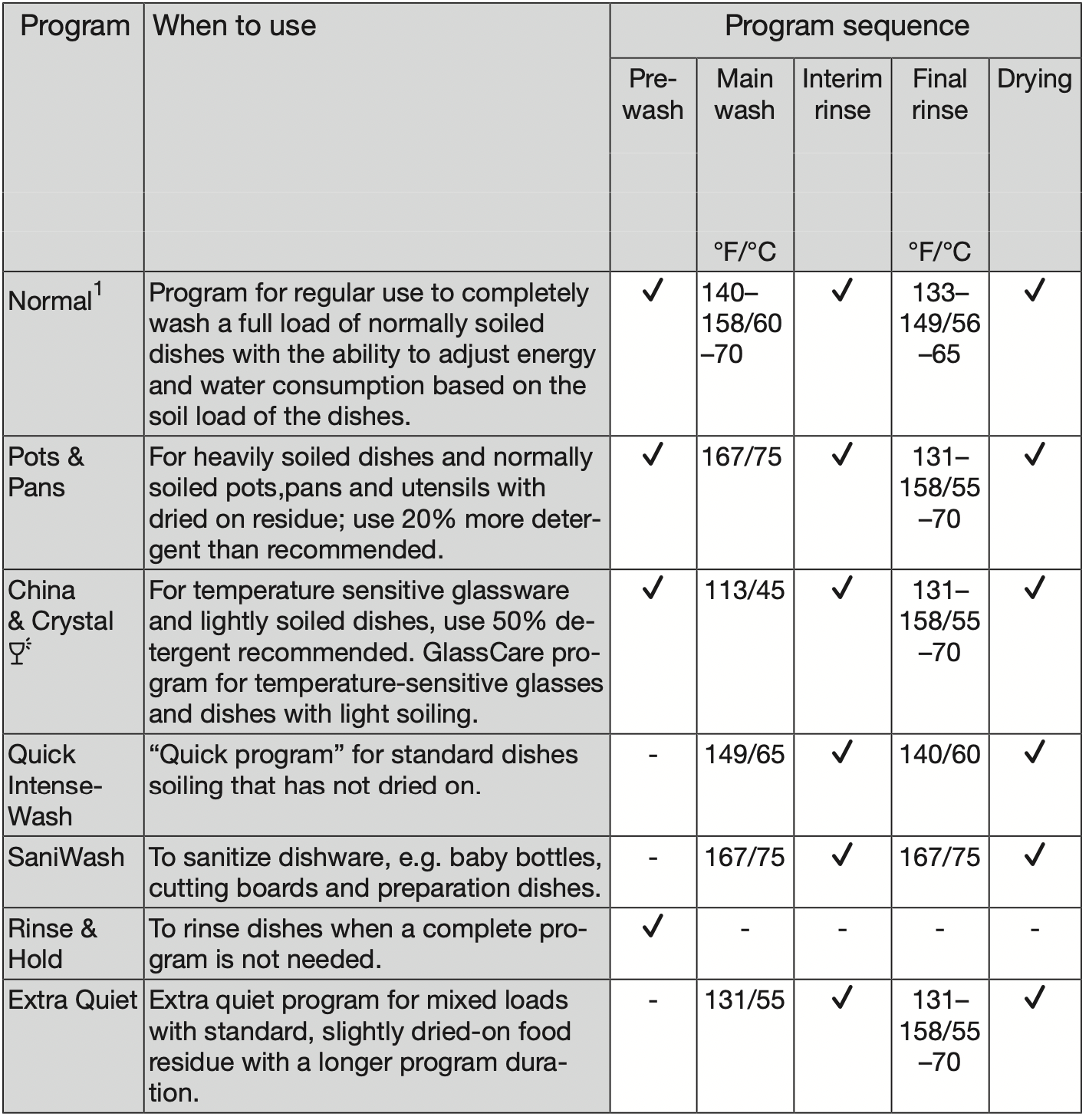
1 This program is used for energy labeling purposes.

2 Values were calculated under standardized testing conditions. In practice there may be variations to these figures due to variable conditions and data recorded by the sensors. Durations shown will reflect your household conditions.
Selecting program options will also affect consumption levels and program durations (see “program options”).
The energy consumption with a hot water supply includes the energy used to heat the water (exception: EnergySaver, if available).

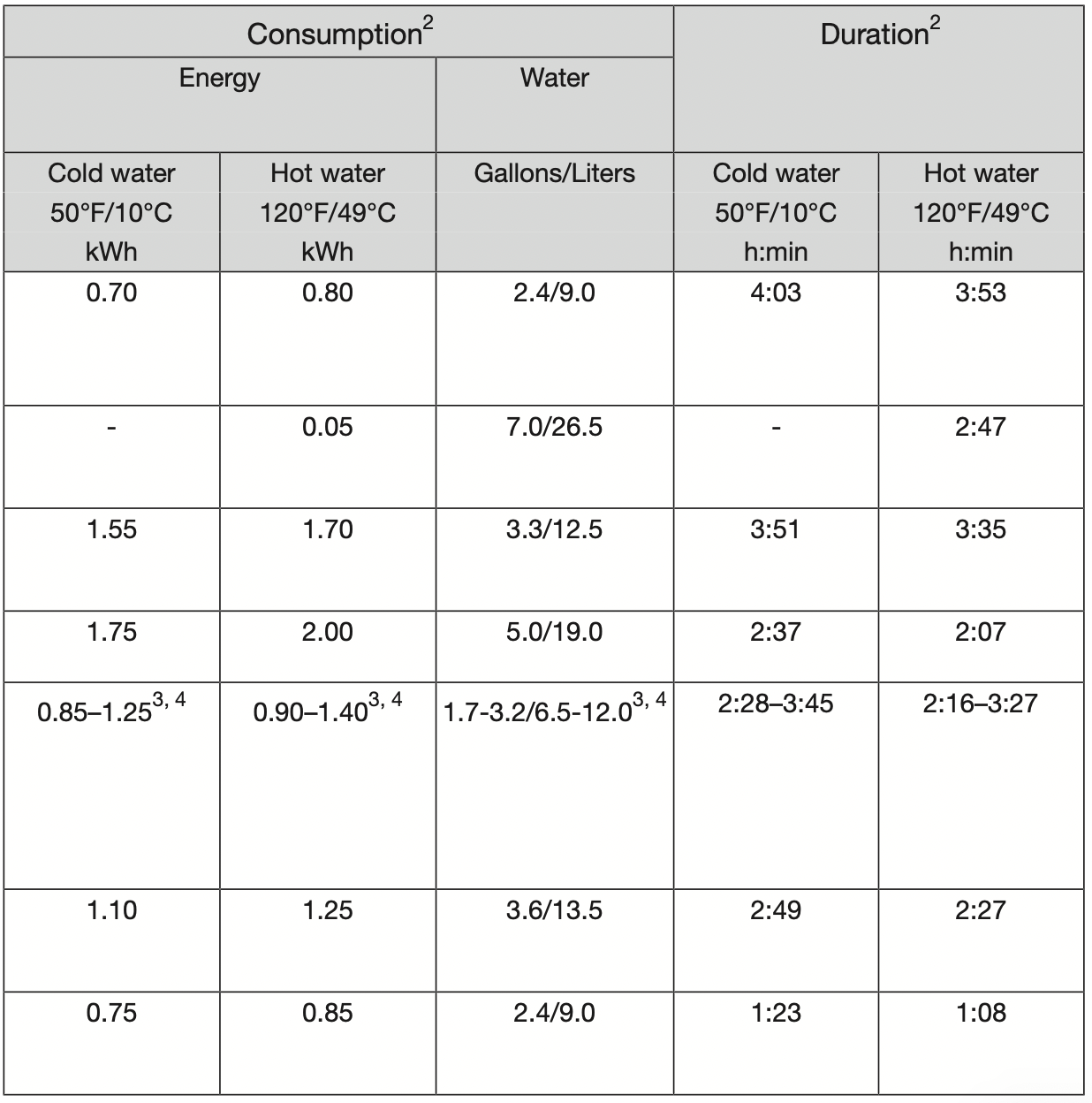
2 Values were calculated under standardized testing conditions. In practice there may be variations to these figures due to variable conditions and data recorded by the sensors. Durations shown will reflect your household conditions.
Selecting program options will also affect consumption levels and program durations (see “program options”).
The energy consumption with a hot water supply includes the energy used to heat the water (exception: EnergySaver, if available).
3 Part load with light soiling
4 Full load with heavy soiling
Selecting options
You can use options to adjust the programs.
To do this, you can select or deselect the options in the Options menu of a selected program before running it.
- Open the door.
- Turn the dishwasher on using the
 sensor button.
sensor button. - Select a different program as required.
All available Options will be shown in the display.
Not all options can be selected in every program or used in combination. Options that are not available are grayed out and cannot be selected.
- Select the options you want.
The selected options are marked in orange.
- If you want to cancel the selection of an option, touch the sensor button for the option again.
- When you have made all the settings you want, close the door to start the program.
The selected options will remain active for that particular program until the settings are changed.
IntenseZone
The IntenseZone option increases cleaning performance in the lower basket.
Energy consumption increases due to the extended wash duration in the lower basket and increased temperature.
Express
The Express option reduces the program cycle time.
In order to achieve optimum cleaning results, the temperature, and therefore the energy consumption, will increase with this option.
The time by which the program cycle time is shortened varies according to the selected program.
Selecting the Express option may take precedence over other selected options.
When used in combination with the QuickIntenseWash program, the Express option results in a rinse designed solely for the purpose of flushing out the wash cabinet to remove salt solution that leaked out after refilling the salt reservoir.
Extra clean
You can select this option to increase the cleaning performance of the programs.
If you activate this option, the program cycle times and the main wash temperatures will increase. The water and energy consumption may increase.
Extra Dry
You can select this option in order to increase the program drying performance.
If you activate this option, the program cycle times and final rinse temperatures will increase. The energy consumption may increase.
Cleaning and care
Check the condition of your dishwasher regularly (approx. every 46 months). This helps to avoid faults and problems.
WARNING: Damage due to unsuitable cleaning agents.
All surfaces are susceptible to scratching. Contact with unsuitable cleaning agents can alter or discolor all surfaces.
Only use cleaning agents formulated for use on the relevant surfaces.
Cleaning the wash cabinet
The wash cabinet is largely self-cleaning, provided that the correct amount of detergent is always used.
The frequent use of low-temperature wash programs increases the risk of contamination and odors inside the wash cabinet. Run the Pots & Pans program once per month to clean the wash cabinet and prevent odors from developing.
However, if residues such as limescale or grease have been deposited, use the Clean Machine program to clean the dishwasher (see “Additional programs  ” under “Program overview”) with dishwasher cleaner (see “Clean Machine” under “Optional accessories”). Follow the dosage recommended by the manufacturer on the packaging.
” under “Program overview”) with dishwasher cleaner (see “Clean Machine” under “Optional accessories”). Follow the dosage recommended by the manufacturer on the packaging.
Miele cleaning and care products are available to order from Miele Customer Service or from Miele’s online store.
- Clean the filters in the wash cabinet regularly.
Cleaning the door and the door seal
The door seal and the sides of the dishwasher door are not accessed and cleaned by the spray arm jets. As a result, mold can develop here.
- Wipe the door seals regularly with a damp cloth to remove food deposits.
- Wipe off any food or drink residues which may have dripped onto the sides of the dishwasher door before closing it.
Cleaning the control panel
- The control panel should only be wiped with a damp cloth.
Cleaning the reflector panel
The reflector panel for the in-operation indicator light is situated on the cover sheeting underneath the countertop.
- The reflector panel should only be cleaned with a damp cloth if necessary.
Cleaning the front of the machine
WARNING: Damage due to soiling.
Soiling that is left too long might become impossible to remove and could cause the external surfaces to alter or discolor.
It is therefore best to remove any soiling immediately.
- Clean the appliance front with a clean soft sponge and a solution of warm water and liquid dish soap. After cleaning, wipe the surfaces dry using a soft cloth.
A clean, damp microfiber cloth without detergent can also be used.
To avoid damaging the external surfaces, do not use the following:
- cleaning agents containing soda, ammonia, acids, or chloride
- cleaning agents containing lime scale remover
- abrasive cleaning agents, such as scouring powder, scouring liquid, or pumice stones
- cleaning agents containing solvents
- stainless-steel cleaning agents
- dishwasher cleaner
- oven cleaner
- glass cleaner
- hard, abrasive brushes or sponges, e.g., pot scourers, brushes, or sponges which have been previously used with abrasive cleaning agents
- eraser sponges
- sharp metal scrapers
- steel wool
- steam cleaners
Cleaning the AutoDos
You should regularly check (about every 2–3 months when the PowerDisk is empty) that the pouring channel is clean, and clean it if necessary. This helps keep the AutoDos working properly.
In order to ensure that the AutoDos works at its best, check it each time you replace the PowerDisk and clean it if needed.
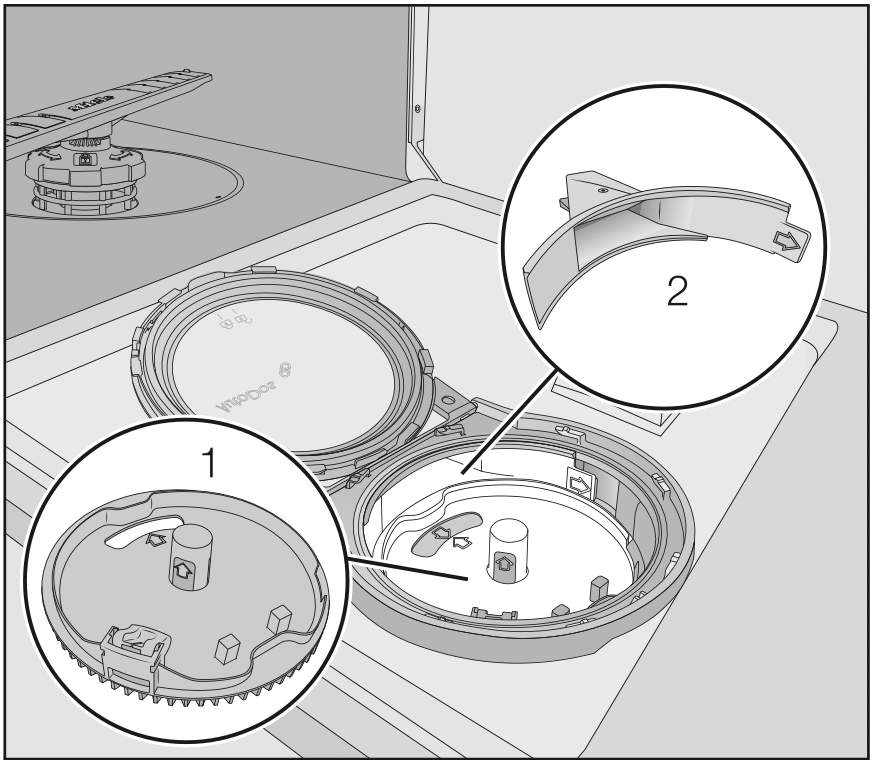
- PowerDisk holder
- Pouring channel for dispensing the detergent from the PowerDisk into the wash cabinet
- Turn the AutoDos lid to
 and open it.
and open it. - Remove the PowerDisk if appropriate.

- Pull the PowerDisk holder upwards by the yellow tabs and remove it. When doing so, do not pull on the side tab.
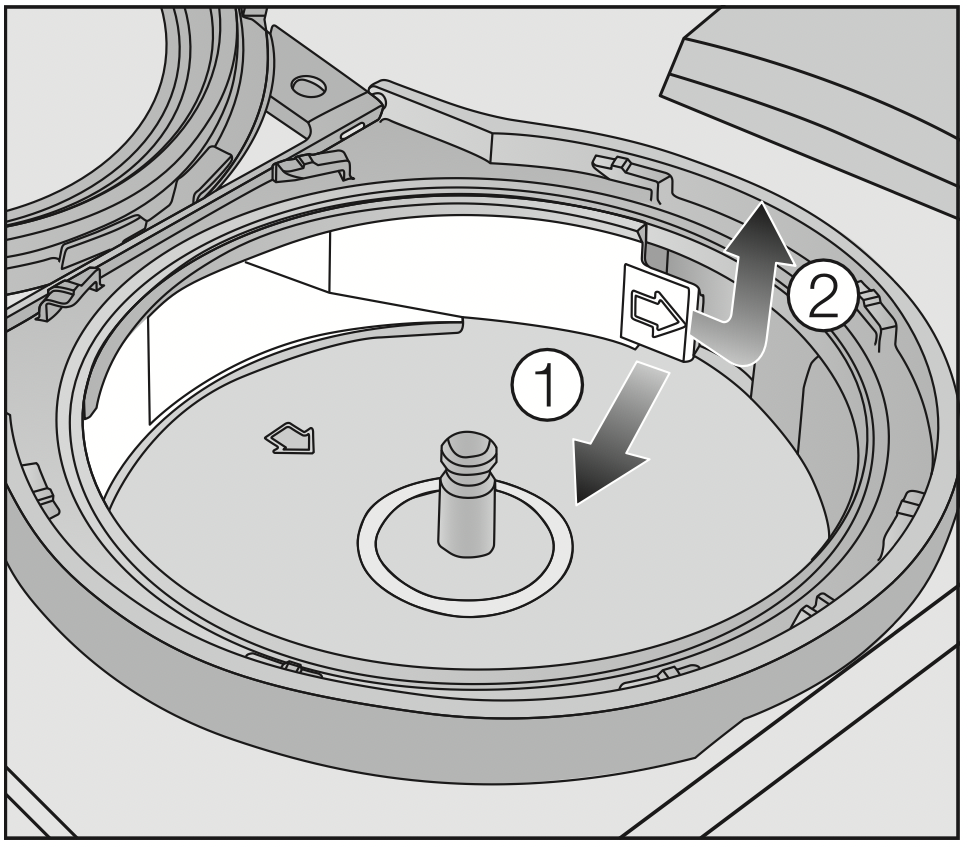
- Use the tab (see arrow) 1 to release the fill channel and pull it out 2.
- Clean the pouring channel using water and a soft brush if necessary.
It is very important that no moisture is able to access the inside of the AutoDos system during cleaning.
- Dry the fill channel well so that the detergent powder does not clump together.
- Insert the fill channel again until the tab clicks into place.
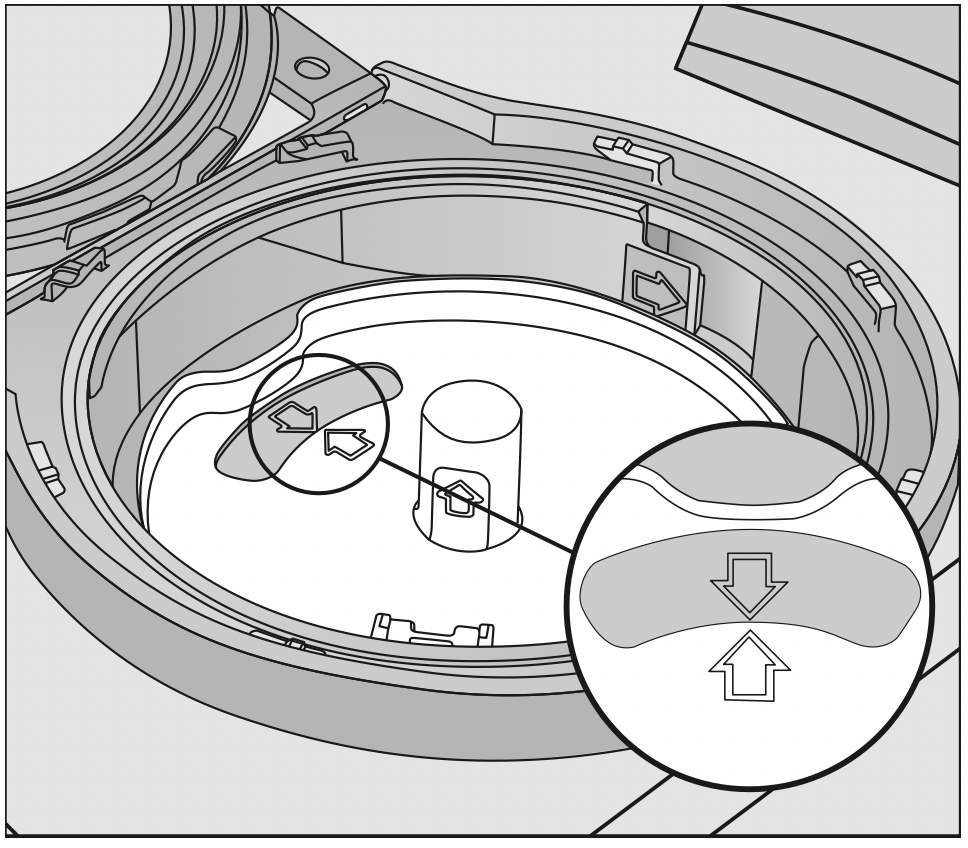
- Put the holder back into place so that the arrows in the PowerDisk holder and in the viewing window point towards each other. The holder must lie flat.
The AutoDos lid must close tightly so that the detergent powder does not get wet and clump together.
Make sure that all seals are clean.
- Insert a PowerDisk.
- Close the AutoDos lid and turn it until the lid handle is directly below the
 symbol (see “Inserting a PowerDisk” under “Detergent”).
symbol (see “Inserting a PowerDisk” under “Detergent”).
Regularly check the lower spray arm for any blockages to ensure that the detergent outlet of the AutoDos can be fully flushed out (see “Cleaning the spray arms” under “Cleaning and care”).
Cleaning the spray arms
Particles of food can get stuck in the spray arm jets and bearings. The spray arms should therefore be inspected regularly (approx. every 2–4 months).
WARNING: Damage due to soiling entering the circulation system.
Without filters, soiling can enter the circulation system and cause a blockage.
Do not run a wash program without the lower spray arm or without the filters.
When cleaning the filters and spray arms, make sure that coarse soiling cannot get into the circulation system.
- Turn off the dishwasher.
Removing the upper and middle spray arms
- Take out the 3D MultiFlex Tray (if your dishwasher is fitted with one).
- Push the upper spray arm upwards to engage the inner ratchet. Then unscrew the spray arm by rotating the screw thread counterclockwise.

- Rotate the screw thread of the middle spray arm clockwise 1 (see diagram) and remove the spray arm 2.
Removing the lower spray arm
- Remove the lower basket.

- Rotate the screw thread of the lower spray arm counterclockwise 1 and pull the spray arm upwards to remove 2.
Cleaning the spray arms

- Use a pointed object to push food particles that are stuck in the spray arm jets into the spray arm.
- Rinse the spray arm thoroughly under running water.
Refitting the spray arms
- Refit the upper and middle spray arms.
- Refit the lower spray arm and ensure that the filter combination lies flat in the base of the wash cabinet.

- Rotate the screw thread of the lower spray arm clockwise until the arrow in the viewing window points to the lock symbol
 .
. - Make sure the spray arms can rotate freely.
WARNING: Damage due to soiling entering the circulation system.
The lower spray arm is used to secure the filter combination. Without filters, coarse soiling can enter the circulation system and cause a blockage.
Do not run a wash program without the lower spray arm or without the filters.
Checking the filters in the wash cabinet
The filter combination in the base of the wash cabinet retains coarse soil from the suds solution. This prevents soiling getting into the circulation system and re-entering the wash cabinet through the spray arms.
WARNING: Damage due to soiling entering the circulation system.
Without filters, soiling can enter the circulation system and cause a blockage.
Do not run a wash program without the lower spray arm or without the filters.
When cleaning the filters and spray arms, make sure that coarse soiling cannot get into the circulation system.
The filters can become blocked by soiling that collects over time. The level of soiling and time it takes before the filters need cleaning will vary depending on use.
The message Remove filters and clean them if necessary will appear in the display after every 50 program sequences.
- Check the filter combination.
- Clean if necessary.
- Then confirm the message with OK.
Cleaning the filters
- Turn off the dishwasher.
- Remove the lower spray arm (see “Cleaning the spray arms” under “Cleaning and care”).
- Before removing the filter combination, remove any coarse soiling to prevent it from entering the circulation system.
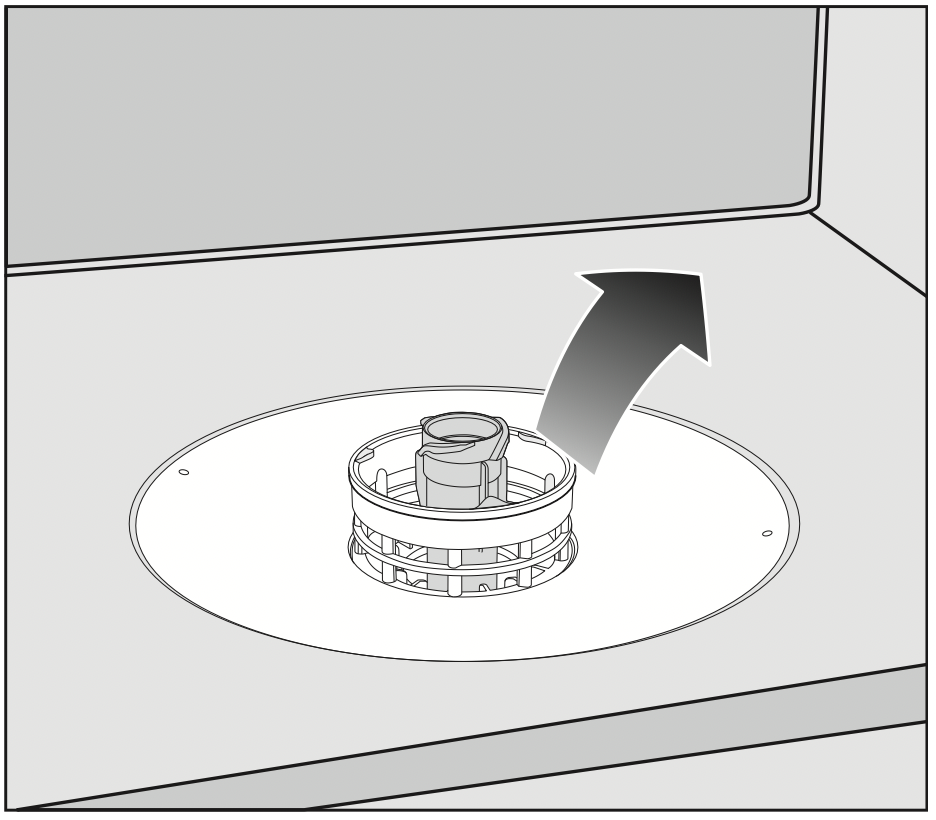
- Remove the filter combination.
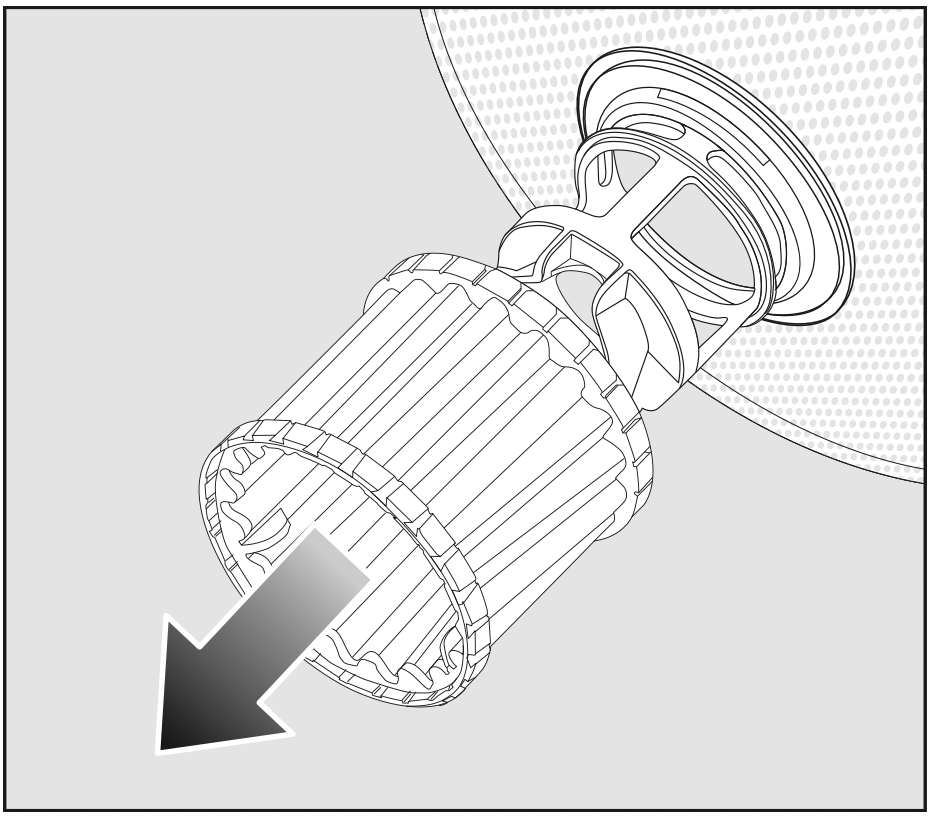
- In order to clean the inside of the filter, pull the microfilter on the plastic ring downwards and away from the filter combination.
- Rinse all of the filters under running water.
If necessary, use a soft cleaning brush to remove soiling. - Insert the microfilter back into the filter combination.
- Reinstall the filter combination so that it lies flat in the base of the wash cabinet.
- Refit the lower spray arm to the filter combination using the screw thread.
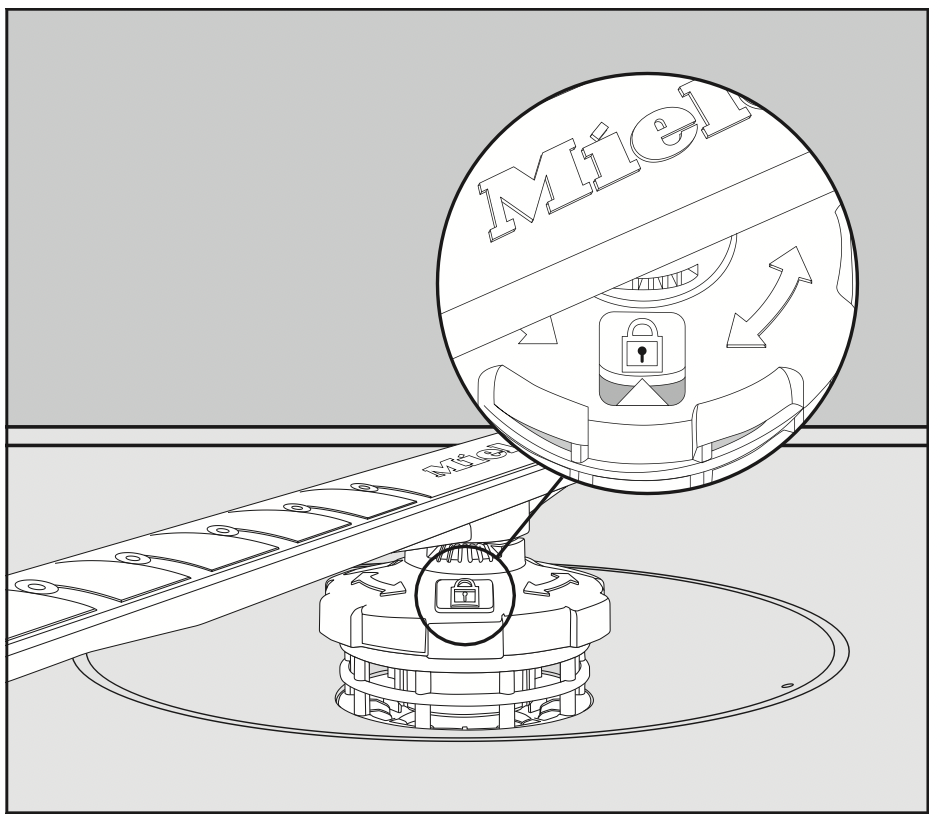
- Rotate the screw thread clockwise until the arrow in the viewing window points to the lock symbol
 .
.
WARNING: Damage due to soiling entering the circulation system.
The lower spray arm is used to secure the filter combination. Without filters, coarse soiling can enter the circulation system and cause a blockage.
Do not run a wash program without the lower spray arm or without the filters.
Cleaning the drain pump
If water remains in the wash cabinet after the end of a program, the water has not been pumped away. The drain pump may be blocked by foreign objects. These foreign objects are easy to remove.
- Disconnect the dishwasher from the power supply.
To do this, turn off at the electrical socket and withdraw the plug. - Take the filter combination out of the wash cabinet (see “Cleaning the filters” under “Cleaning and care”).
- Scoop the water out of the wash cabinet using a suitable small container or utensil.
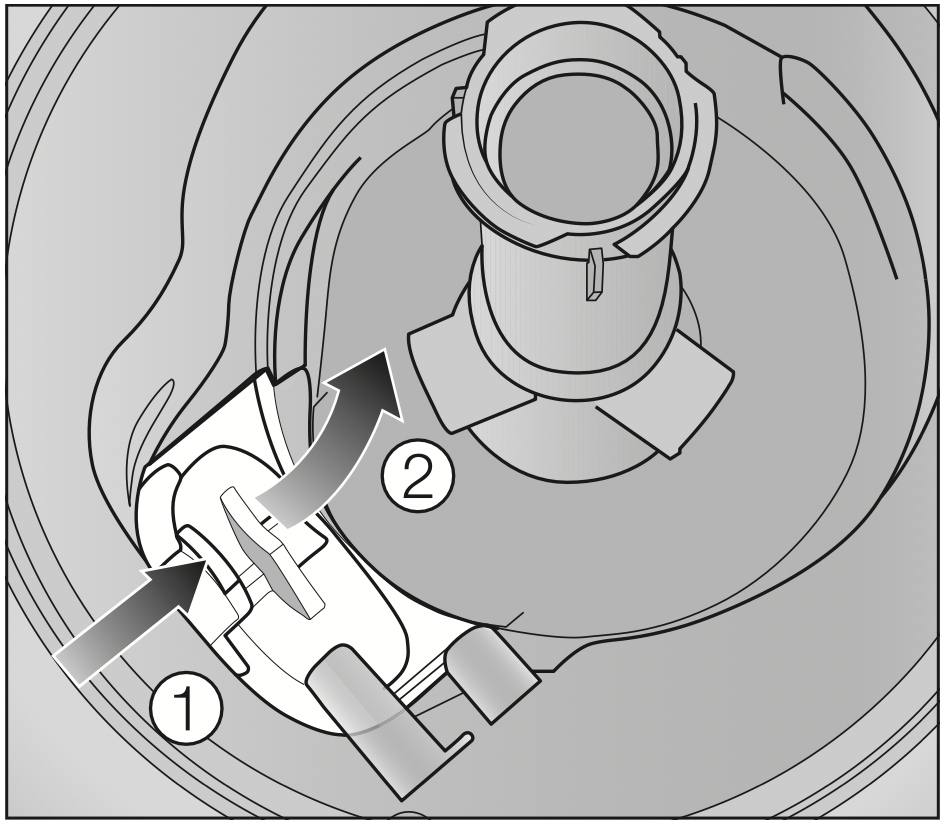
- Press the catch of the drain pump cover inwards 1.
- Tip the cover inwards until it is released 2.
- Rinse the cover thoroughly under running water and remove all foreign objects.

The drain pump (see arrow) is underneath the cover.
WARNING: Risk of injury from glass splinters.
It is especially difficult to see glass splinters in the drain pump.
Take care when cleaning the drain pump.
- Carefully remove all foreign objects from the drain pump. Check the drain pump impeller by manually turning it. You will feel a little resistance when you turn the impeller.
- Refit the cover by placing it down vertically from above.
Ensure that the catch engages correctly.
WARNING: Damage due to incorrect cleaning.
The components are delicate and can be damaged during cleaning.
Take care when cleaning the drain pump.
Troubleshooting
With the help of the following guide minor faults in the performance of the machine, some of which may result from incorrect operation, can be remedied without contacting the Service Department.
This guide may help you to find the reason for the fault, and how to correct it.
This section only lists faults that you can remedy yourself. All other faults are shown in  Fault FXX.
Fault FXX.
Technical faults
|
Problem |
Possible cause and solution |
|
The dishwasher does not start. |
The door is not properly closed.
|
|
The dishwasher is not plugged in.
|
|
|
The circuit breaker has tripped.
|
|
|
The dishwasher is not turned on.
|
|
|
The dishwasher stops during a program. |
The circuit breaker has tripped.
|
|
After the program has started, the in-operation indicator light is not visible. |
The reflector panel was not correctly fitted.
|
Fault messages
|
Problem |
Possible cause and solution |
|
The in-operation indicator light is flashing quickly. The alarm tone is sounding. One of the following faults appears in the display: |
Before remedying the fault:
|
|
|
There may be a technical fault.
If the fault message appears again, there is a technical fault.
|
|
|
The Waterproof system has reacted.
|
|
|
Circulation-pump fault.
If the fault message appears again, there is a technical fault.
|
Door release
|
Problem |
Possible cause and solution |
|
The in-operation indicator light is flashing quickly. The alarm tone is sounding. The following fault is indicated via the display: |
Before remedying the fault:
|
|
|
The door does not open automatically. There may be a technical fault.
|
|
The door does not close automatically. The door might be obstructed by an item inside the appliance.
|
Water intake fault
|
Problem |
Possible cause and solution |
|
The in-operation indicator light is flashingquickly. The alarm tone is sounding. One of the following messages appears in thedisplay: |
|
|
|
The water supply is turned off.
|
|
|
Before remedying the fault:
|
|
There is a problem with the water intake.
|
|
|
|
A technical fault has occurred.
|
|
The following fault message appears during the EnergySaver program: |
The intake water has not reached the required temperature of 115 °F (45 °C) (see “Water intake” under “Installation”).
|
Water drainage fault
|
Problem |
Possible cause and solution |
|
The in-operation indicator light is flashing quickly. The alarm tone is sounding. The following message appears on the display: |
Before remedying the fault:
|
|
Water-drainage fault. There might be water in the wash cabinet.
|
Fault in the AutoDos (automatic dispensing)
|
Problem |
Possible cause and solution |
|
The following message appears on the display: |
The AutoDos function is active but no PowerDisk has been inserted.
|
|
The in-operation indicator light is flashing quickly. The alarm tone is sounding. The program does not start or a program that hasalready started stops. The following message appears on the display: AutoDos lid open |
The AutoDos lid has not been closed properly.
|
|
The following message appears on the display: PowerDisk empty. Deacti- vate AutoDos with OK. |
The AutoDos function is active and the PowerDisk is empty.
|
|
The message PowerDisk empty. Deactivate AutoDos with OK. appears in the display even though you have inserted anew PowerDisk. |
The dishwasher was turned off when the PowerDisk was replaced and it has therefore not recognized the new PowerDisk.
|
|
The in-operation indicator light is flashing quickly. At the end of the program, the alarm tone sounds and the display shows the following message:
|
There is a fault in the AutoDos.
If the fault message appears again, there is a technical fault. You can continue to use your dishwasher by deactivating AutoDos in the Options menu of a programand manually dispensing the detergent via the detergent compartment.
|
|
The in-operation indicator light is flashing quickly. At the end of the program, the alarm tone sounds and thedisplay shows the following message: AutoDos maintenance required. Please check AutoDos system. The dishwasher does not turn off at the end of the program. The dishware may not be clean because an in-sufficientamount of detergent was dispensed. The AutoDos function is automatically deactivated during the program sequence. |
An empty PowerDisk has been inserted or the AutoDos is blocked by residual detergent. Detergent dosage is insufficient. The AutoDos function was automatically deactivated.
Multiple messages appear in the display.
The program duration will be extended by up to 2.5 hours to flush out theAutoDos detergent outlet. |
Spray arm fault
|
Problem |
Possible cause and solution |
|
During the program and at the end of the program, the display shows the following message: Check spray arms The dishwasher does not turn off at the end of theprogram. The dishware may not be clean because no detergent was dispensed. The AutoDos function is automatically deactivated during the program sequence. |
The lower spray arm is blocked or the nozzles of the lower spray arm are clogged. The AutoDos function is automatically deactivated during the program because the AutoDos detergent outlet cannot be completely flushed out.
Messages appear in the display.
|
General dishwasher problems
|
Problem |
Possible cause and solution |
|
The door will not open when knocked. |
The Knock2open function has been permanently dis- abled.
If the door still will not open or if there is a power failure, the door can still be opened manually using the door-opening aid supplied (see ”Door-opening aid” under "Before using for the first time”). |
|
The in-operation indicator light isflashing quickly. The alarm tone is sounding. The message Press “OK” to continue will appear on the display. The dishwasher does not start or theFlexiTimer stops running. |
The safe mode of the dishwasher was activated. This takes place in the following instances:
Confirm with OK and close the door within 4 seconds. |
|
The indicator lights and the display are dark. |
The dishwasher has turned off automatically to save energy.
|
|
The wash cabinet lighting does not come on when the door is opened. |
The wash cabinet lighting has been turned off permanently.
|
|
Faulty wash cabinet lighting.
|
|
|
Detergent residue is left in the detergent compartment at the end of a program. |
The detergent compartment was still damp when detergent was added.
|
|
The detergent compartment lid cannot be closed. |
Residual detergent is blocking the catch.
|
|
At the end of a program there is a film of moisture on the inside of the door and possibly on the interior cabinet walls. |
This is part of the normal function of the drying system. The moisture will dissipate after a short time. |
|
Water remains in the wash cabinet at the end of a program. |
Before remedying the fault:
|
|
The filter combination in the wash cabinet is clogged. Clean the filter combination (see “Cleaning the filters” under “Cleaning and care”). |
|
|
The drain pump is blocked.
|
|
|
The drain hose is kinked.
|
Noises
|
Problem |
Possible cause and solution |
|
There is a knocking noise in the wash cabinet. |
A spray arm is knocking against a wash item.
|
|
There is a rattling noise in the wash cabinet. |
Wash items are not secure in the wash cabinet.
|
|
There is a foreign object (e.g., glass shard) in the drain pump.
|
|
|
Knocking noise in the water pipes |
This may be caused by the on-site installation or the cross-section of the piping.
|
Poor cleaning results
|
Problem |
Possible cause and solution |
|
The dishes are not clean. |
The dishes were not loaded correctly.
|
|
The program was not powerful enough.
|
|
|
Not enough detergent was dispensed during manual detergent dispensing.
|
|
|
Items are blocking the path of the spray arms.
|
|
|
The filter combination in the wash cabinet is not clean or wasincorrectly fitted. This may have caused the spray arm jets to become blocked.
|
|
|
There are smears on glassware and cutlery. There is a bluish sheen on the surface of glassware. The film can be wiped off. |
The rinse aid dosage is set too high.
|
|
The dishware is not dry or utensils and glasses are spotty. |
The rinse-aid dosage is set too low or the rinse-aid reservoir is empty.
|
|
The dishware was taken out of the wash cabinet too soon.
|
|
|
The duration of the drying phase for the selected program is not sufficient for the dishware.
|
|
|
You have used combination products that have insufficient drying performance.
|
|
|
Glassware has a brown or blue tinge. The film cannot be wiped off. |
Ingredients from the detergent have formed a deposit.
|
|
Glassware is dull and discolored. The film cannot be wiped off. |
The glassware is not dishwasher-safe. The surface has altered.
|
|
Tea or lipstick stains have not been completely removed. |
The wash temperature of the selected program was too low.
|
|
The bleaching effect of the detergent is too low.
|
|
|
Plastic parts are discolored. |
Natural dyes, e.g., from carrots, tomatoes, or ketchup may be the cause. The amount of detergent used or its bleaching effect was not sufficient to deal with natural dyes.
|
|
White residue is visible on the dishes. Clouding has occurred on glassware and cutlery. The film can be wiped off. |
The rinse aid dosage is set too low.
|
|
The salt reservoir is empty.
|
|
|
The salt reservoir cap has not been screwed on correctly.
|
|
|
Unsuitable combination detergents were used.
|
|
|
The water softener is programmed to too low a water hardness level.
|
|
|
There are rust stains on the utensils. |
The affected items are not corrosion resistant.
|
|
A program was not run after reactivation salt was added. Traces of salt have got into the normal wash cycle.
|
|
|
The salt-reservoir cap has not been screwed on correctly.
|
 sensor button.
sensor button. Waterproof fault. Turn the appliance off, close the water supply and contact Miele Service.
Waterproof fault. Turn the appliance off, close the water supply and contact Miele Service. Fault F 78: A technical fault has occcurred. Turn off the appliance, close the water supply and contact Miele Service.
Fault F 78: A technical fault has occcurred. Turn off the appliance, close the water supply and contact Miele Service. Fault F 33: Open the door manually. Contact Miele Service.
Fault F 33: Open the door manually. Contact Miele Service. Open the water supply
Open the water supply Insufficient water. Open the water supply all the way. Refer to Operating Instructions if necessary
Insufficient water. Open the water supply all the way. Refer to Operating Instructions if necessary Fault F 18: A technical fault has occcurred. Turn off the appliance,close the water supply and contact Miele Service.
Fault F 18: A technical fault has occcurred. Turn off the appliance,close the water supply and contact Miele Service. Water was not pumped away, see Operating Instructions
Water was not pumped away, see Operating Instructions Fault F 601: A fault has occured, turn the appliance off then back on again. Restart the program. If the fault occurs agian, contact Miele Service.
Fault F 601: A fault has occured, turn the appliance off then back on again. Restart the program. If the fault occurs agian, contact Miele Service. sensor button.
sensor button. Quick Intense Wash 65°C program with the Express program option selected and without any wash items afteradding reactivation salt.
Quick Intense Wash 65°C program with the Express program option selected and without any wash items afteradding reactivation salt.